Porsche 911 Brake Upgrade Guide
03.06.2024This article is designed as a roadmap for upgrading the brakes on a modern Porsche 911, based on the environment and manner in which the car is being driven. The primary focus is on the 911 T trim level, as it and the Base 911 come from the factory with the smallest and most primitive brake package Porsche offers. As such, the brakes on this model have the greatest room for improvement. Everything in this article is also applicable to the other 911 trim levels, but the comparative weights and capabilities will be slightly different vs. the stock brake components on those trim levels.
For many Porsche purists, the Carrera T has become the sweet spot in the current 911 lineup. Lightened and stripped of some frillier bits, available with a manual transmission, and just an ECU tune away from GTS levels of power, it is a great foundation for a road and track toy. Unfortunately, tiny 330mm brake discs at both ends of the car aren’t congruous with the rest of the car's performance envelope, particularly once the boost is cranked up. The brakes also look a bit lost inside the OEM 20"/21" wheels. Fortunately, there is a wide array of brake solutions available, regardless of how you intend to use your car.
A common problem Porsche owners face when upgrading their brakes is that they don’t know which products most closely match their needs. There are a million different brake products on the market, and understanding which is the most appropriate for your situation can not only dramatically improve your driving experience and lap times, but it can also save you a lot of money! Your upgrade path should be dictated by how you plan to drive your car.
Daily Driving
If you never plan to do anything with your 911 other than drive it to work every day, there’s a solid chance you’ll be perfectly happy with the OEM brakes as delivered. Just about every modern car today has decent brakes, with far superior technology and performance vs. the cars our parents drove when we were kids. OEM brakes are designed for safety above all else. All other considerations are secondary:
- Shortest stopping distance possible- Occasionally, a kid chases a ball into the road, or a deer jumps from the trees at an inopportune moment. The goal is to stop the car in the shortest possible distance to avoid a collision. The basic brake components are selected to achieve that goal based on the vehicle layout (RWD, FWD, etc.), weight, power, tires, etc.If you want shorter stopping distances, buy stickier tires!
- Stability- Inclement weather, limited driver skill, and chance all create road conditions that negatively impact a vehicle’s stability. Modern brake systems are designed to maintain as much stability under as many conditions as possible. ABS, traction control, and stability control systems all allow a driver to turn while braking and help keep the car pointed in the desired direction. These systems also contribute to the point above, getting the car stopped and safe as quickly as possible.
- Repeated stops at max load- Manufacturers know their cars will be driven in rush-hour traffic, filled to the brim with gear from a local big box store, and/or possibly towing something at the vehicle’s max recommended load rating. Under those conditions, the car needs to be able to stop repeatedly in an acceptable manner.
Achieving the above objectives are enough for most cars and drivers on the road. For a specialized sportscar however, the manufacturer usually goes a bit above and beyond these essentials. Factors such as pedal feel, pedal travel, pad compound feel, fade resistance under heavier than normal use, etc. all come into play. The manufacturer addresses these issues to make their car a competitive performer in the market, all while attempting to manage their costs as tightly as possible. If your primary objective is for your 911 T to safely transport you from one place to another, you’ll be fine leaving your stock brakes alone.
Spirited Street Driving
Enthusiasts tend to be a little tougher on equipment than ‘non-car people’. They accelerate, turn, and brake harder on a regular basis, and they have higher performance expectations. Aggressive driving on back roads, canyons, etc. puts more heat into the brake system than running errands ever could. While manufacturers expect a sportscar to be driven harder than a minivan, exactly how much harder leaves a lot of room for interpretation. Your idea of being tough on brakes may differ vastly from a brake engineer’s thoughts on the subject. Below is a list of upgrades that can be considered for aggressive street driving, in order of importance:
High Performance Brake Pads- If you plan to drive your car hard on the street, high performance pads will be your number one upgrade for improving brake feel and performance. Pad materials can have dramatically different maximum temperature thresholds, fade resistance wear rates, impact on discs, etc. As such, the topic of pad choice is beyond the scope of this article. At Essex, our top recommendation for spirited street driving pads is the extremely versatile and capable Ferodo DS2500 compound. For more details on this pad compound, please read our Essex Blog article, “Which Ferodo Pad Compound is Right for Me?”
991.2 and 992.1 Carrera T front Ferodo DS2500
991.2 and 992.1 Carrera T rear Ferodo DS2500
Stainless Steel Brake Lines- While most people won’t notice a tremendous difference under street driving conditions, SS lines can enhance pedal feel, offer greater protection against road debris, and offer a slightly faster reaction time for brake activation. The bigger advantage with stainless steel lines on a 911 is that our flexible Spiegler lines allow the front caliper to be unbolted from the suspension upright without having to disconnect the brake line or brake line bracket. That means you won’t have to worry about disconnecting your brake lines and potentially getting air into your brake system at every pad change. Our front Spiegler line kit for the Carrera T replaces the hard line to which the red arrow points in the photo below.
991.2 and 992.1 Carrera T front Spiegler Stainless Steel Brake Lines
991.2 and 992.1 Carrera T rear Spiegler Stainless Steel Brake Lines
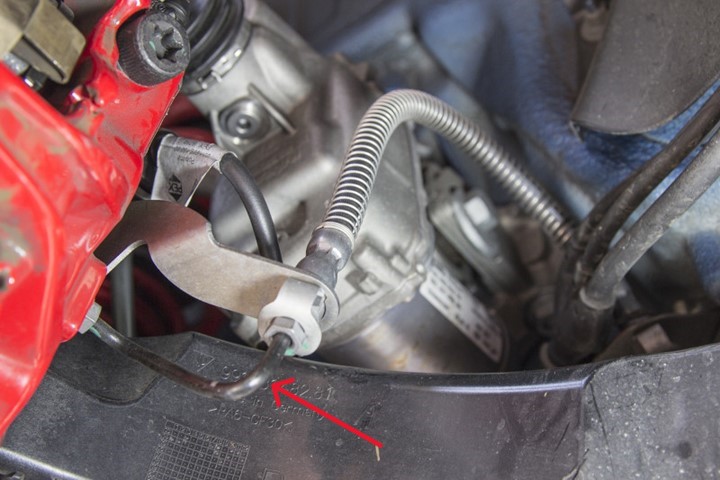
Spiegler stainless steel fitting on the right vs. a competitor’s fitting on the left.
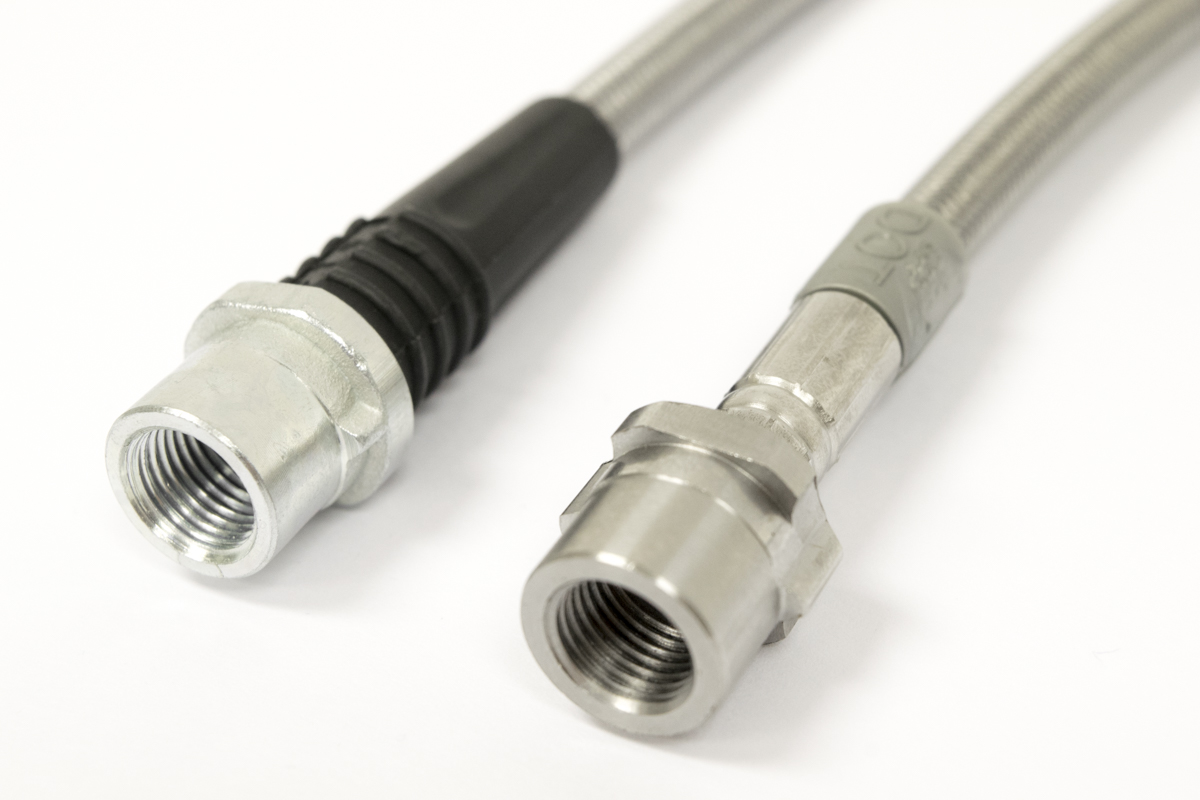
High Performance Brake Fluid- It is highly unlikely that you’ll boil your brake fluid during aggressive street driving. The more likely scenario is that you’ll only need to flush your brake fluid at regular service intervals. When you do, it never hurts to go with a slightly higher spec than stock if you plan to drive your car hard off the beaten path.
- A high-performing and economical choice is AP Racing DOT5.1 fluid, which features a dry boiling point of 516°F.Three 500 ml bottles are typically ample to completely flush your system and still have some left over for a secondary bleed.

Notes on drilled and slotted brake discs- The purpose of the factory drilled discs on a 911 is provide more leading edges for the brake pads to bite into vs. a plain-face disc. Slotted discs exist for the same reason. Many claim that the main purpose of slotted or drilled discs is for pad material and water to evacuate the pad/disc interface, but this is a secondary function. Slotted discs can be marginally more prone to cracking than plain face discs, but that depends on how the specific slot pattern is implemented into the disc. For example, AP Racing’s J Hook slot pattern is specifically designed to evenly spread heat across the disc face without increasing its propensity to crack. Drilled discs, regardless of whether the holes are cast in or drilled after the casting process, are more prone to cracking than plain face or slotted discs (see image below). They do provide even more leading edges for pad bite, and a slight weight reduction. They also look snazzy. Slotted and drilled discs will wear your pads out a little more quickly than plain face discs. All those leading edges assist with bite, but also increase pad wear rates. Disc holes and slots will also make more scraping and whirring noises than plain face discs, so there are some NVH (Noise Vibration Harshness) tradeoffs as well. For most drivers hustling their car around back roads, the OEM discs will be perfectly adequate.
Below is what an OEM drilled disc usually looks like after minimal track use
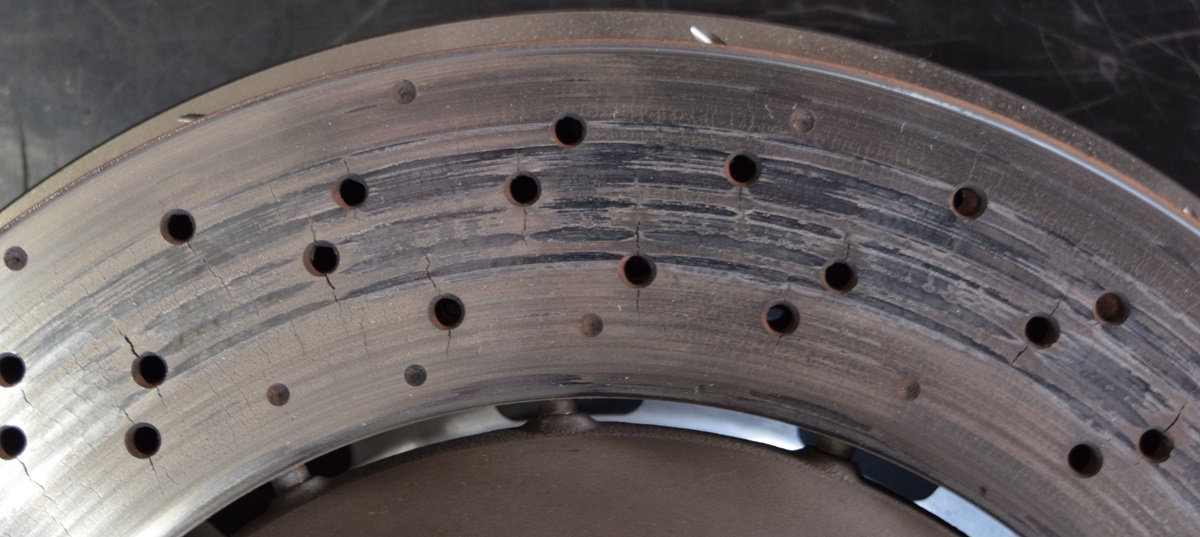
AutoX (Autocross)
Autocross presents a unique challenge for your car's brakes. Depending on the course layout, the amount of pad heat generated may not be much greater than stop-and-go traffic driving. Many times, you never get out of second gear, which means speeds are generally limited to roughly 60 or 70 mph or less. Additionally, the flowing nature of a well-designed autocross course means that you don't always scrub off a tremendous amount of speed entering each brake zone. Often, you are trail-braking as you approach the apex of the corner, rather than standing on the brakes in a straight line. Therefore, precise control and feedback is what you're looking for from your brakes in AutoX, and below are some worthwhile brake upgrades to consider:
High Performance Brake Pads- You’ll need a brake pad with good cold bite, predictable torque response, good all-weather performance, and a simple bed-in procedure. Our favorite at Essex is the Ferodo DS2500, which is one of the absolute best ‘do everything’ pads available on the market today. It works incredibly well on the street, at autoX, and for light track duty. One of our 991 GT3 customers won the 2023 SCCA AutoX championships with Ferodo DS2500 pads mated to our 2-piece AP Racing J Hook Discs. Click here to see one of his winning course runs.
991.2 and 992.1 Carrera T front Ferodo DS2500
991.2 and 992.1 Carrera T rear Ferodo DS2500
Slotted/Drilled Discs- Brake feel is extremely important in autocross, so for many drivers, slotted or drilled discs are worth the investment for the added touch they impart. Wear rates and NVH are secondary concerns when you’re fighting for every hundredth of a second. The OEM Carrera T discs are a fine choice for AutoX.
Stainless Steel Brake Lines- As with discs, every little bit of added feel can mean the difference between winning or losing in a tightly contested AutoX. As such, properly made SS lines are a no-brainer upgrade with no downsides. Also, if you are constantly swapping back-and-forth between street pads and a dedicated set of AutoX pads, our Spiegler Stainless Steel Brake Lines will be a godsend for making that process faster and easier. Spiegler USA is owned and operated by a German engineer and Porsche owner/enthusiast, who imports his Porsche-specific stainless steel line fittings from Switzerland. Spiegler Lines are constructed in Ohio from the finest components we have ever seen.
991.2 and 992.1 Carrera T front Spiegler Stainless Steel Brake Lines
991.2 and 992.1 Carrera T rear Spiegler Stainless Steel Brake Lines
High Performance Brake Fluid- While fade isn’t typically an issue at AutoX, your increased maintenance and continual setup changes may mean that you’re under the car tinkering with your brakes more often than you would be if you were only driving it on the street. As such, keeping some high-quality brake fluid in the car as added insurance never hurts, nor does a good bleed for maintaining a firm and responsive brake pedal. As with street driving, AP Racing DOT5.1 is ample for autoX use, and it’s economical.
Two-piece Brake Discs- Unsprung weight is the devil to the avid autocrosser. You should always be looking to maximize weight reduction within the boundaries of the rules (or outside those boundaries if you’re clever at it!:p). Weight reduction in the wheels/brakes/suspension area is particularly beneficial to all aspects of acceleration, turning, and braking, which is the core of autoX. Two-piece discs can in some cases offer substantial weight savings. Aftermarket two-piece discs will have aluminum hats that are lighter than the stock iron pieces, and their overall construction and vane design may offer further weight savings. Since you probably won’t be burning your discs up at a rapid rate, the initial cost of a two-piece disc may be worth the weight loss (commonly $600-$1800 per pair). Just make sure to check the price of replacement iron before committing, since you will eventually need to change the discs which are wear items. Also, keep the size and mass of the discs in mind. A larger-than-stock 2-piece disc may weigh more than the OEM units, which is even more likely on the Carrera T since the OEM discs are so tiny.
Essex recommends AP Racing 2-piece Competition J Hook discs for their incredible durability and cooling capacity. Our J Hook Discs are 20mm larger than the stock 330mm discs at both ends of the car. AP Racing J Hooks have proven to be the most durable, coolest-running discs on the market, and the J Hook slot pattern does a great job of mitigating cold spots on the disc, which often leads to uneven pad deposits and brake judder. Even though our 350mm discs are considerably larger than stock, our fronts only weigh one pound more than the OEM 330mm discs, and our rears are actually each one pound lighter. Therefore, the unsprung weight of our discs is essentially a wash with the stock units, so there are no real downsides to upgrading if your AutoX class allows for them.
Front AP Racing J Hook Disc Pair for the 991.2 and 992.1 Carrera T
Rear AP Racing J Hook Disc Pair for the 991.2 and 992.1 Carrera T
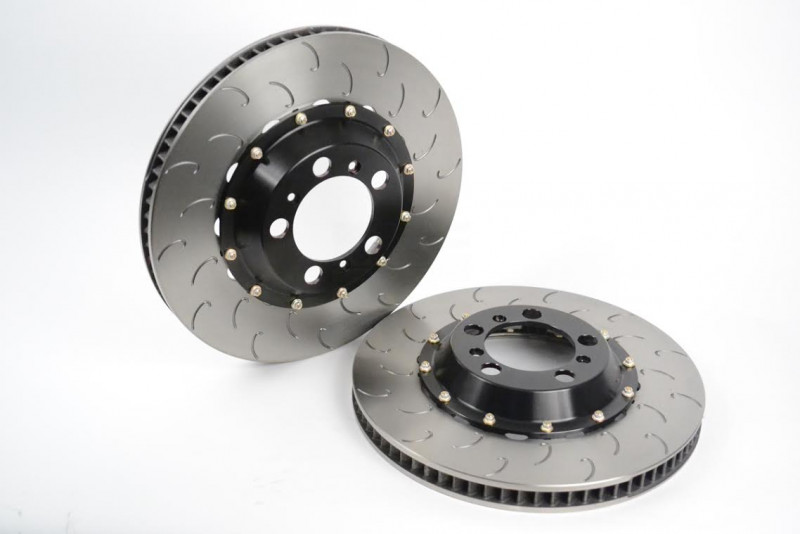
An AP Racing by Essex J Hook next to an OEM 911 T Disc
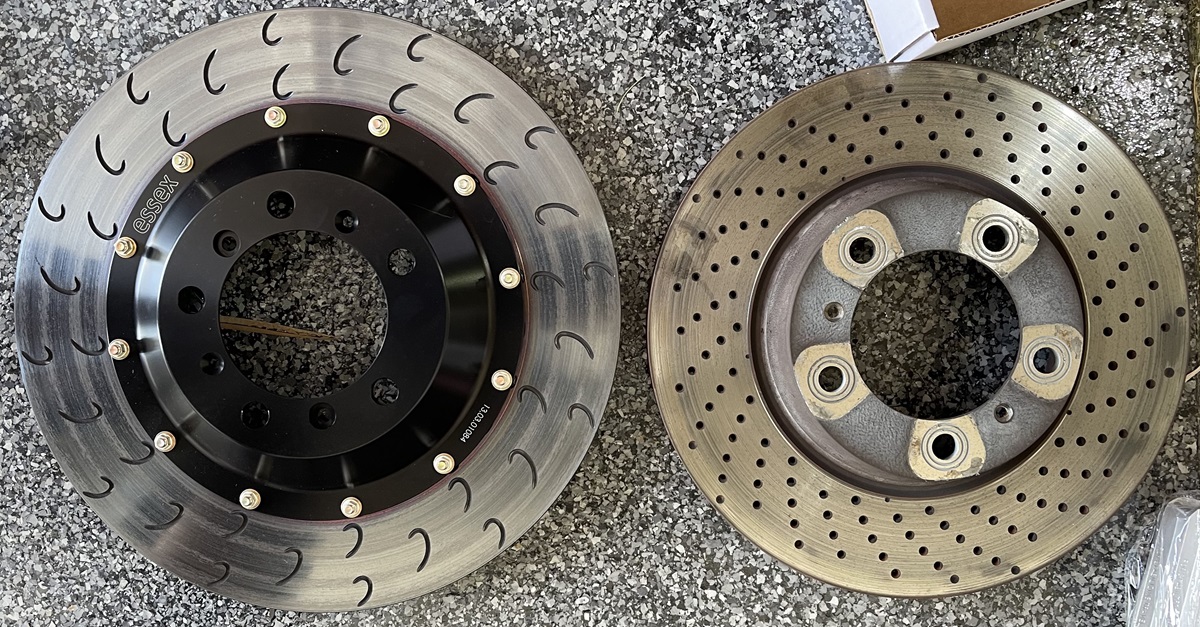
2-piece J Hooks installed on a couple 991s
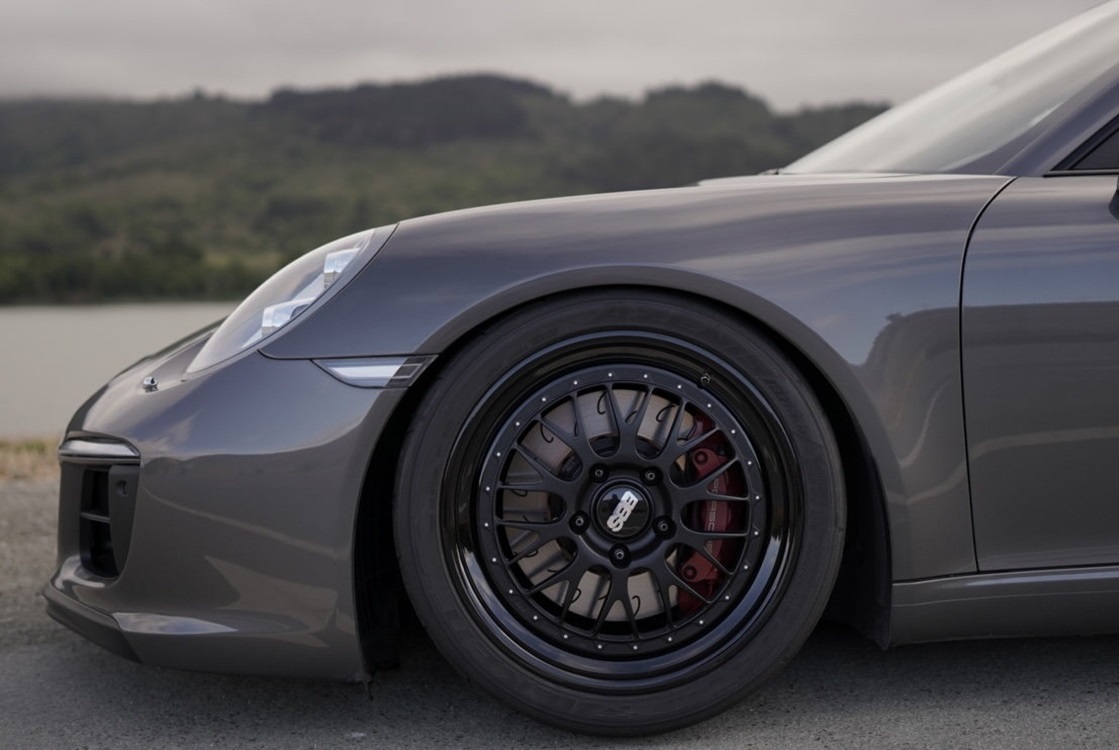
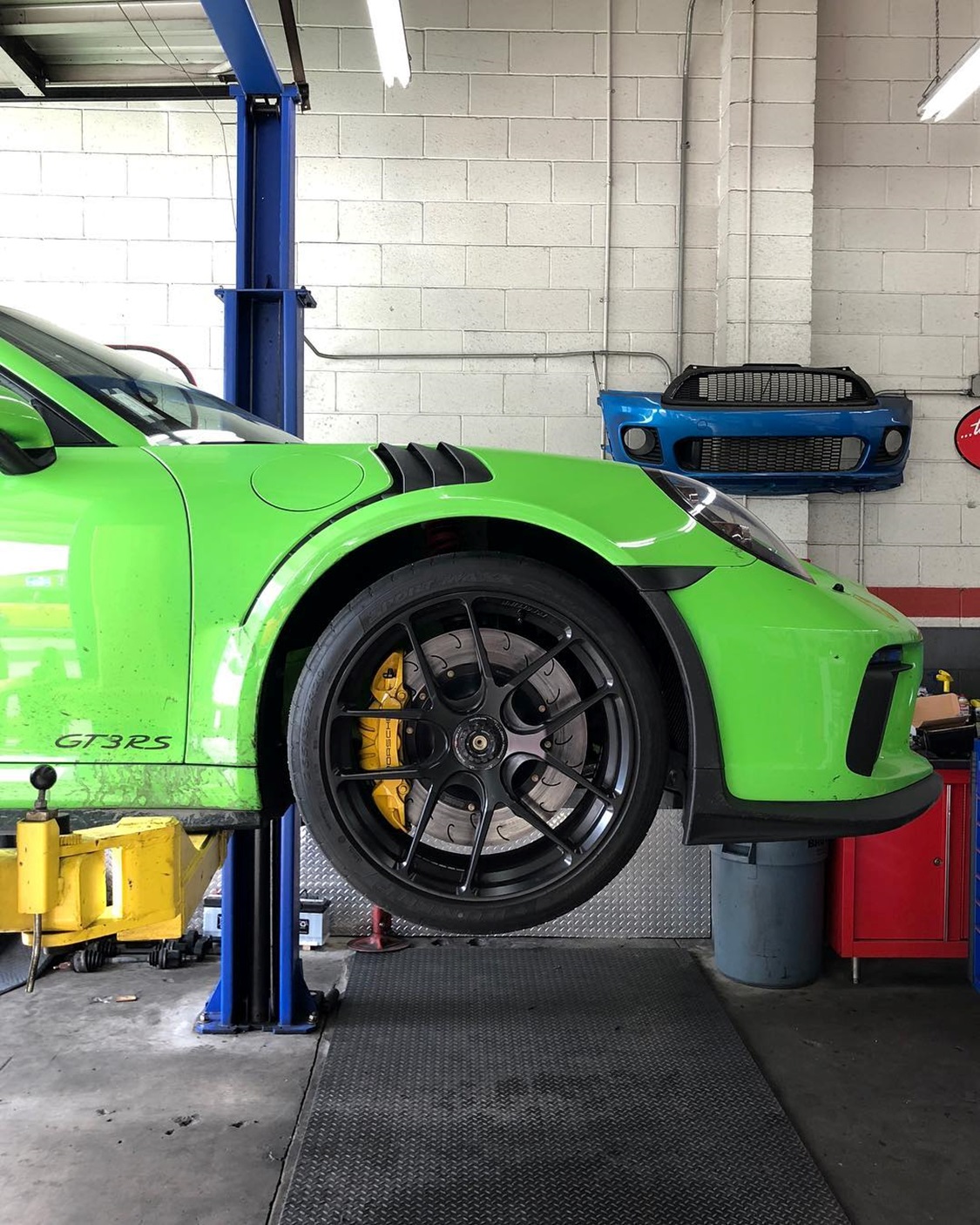
Essex Brake Bundles- If you find the individual brake products highlighted above compelling, we've made it even easier to obtain them in the form of our Essex Brake Bundles. The goal with our brake bundles is to deliver a highly effective collection of brake components, all-in-one-box solution, and at a discounted price. We offer two different types of bundles:
- Essex Pad, line, fluid bundle- Ferodo Pads of your choice, Spiegler Lines, and AP Racing R3 brake fluid.
- Essex Pad, line, fluid, and 2-piece Disc bundle- Ferodo Pads of your choice, Spiegler SS Lines, AP Racing R3 Fluid, and AP Racing 2-piece J Hook Discs designed to mate with your OEM calipers.
992 Carrera T front pad, line, fluid bundle
992 Carrera T rear pad, line, fluid bundle
992 Carrera T front pad, line, fluid, disc bundle
992 Carrera T rear pad, line, fluid, disc bundle
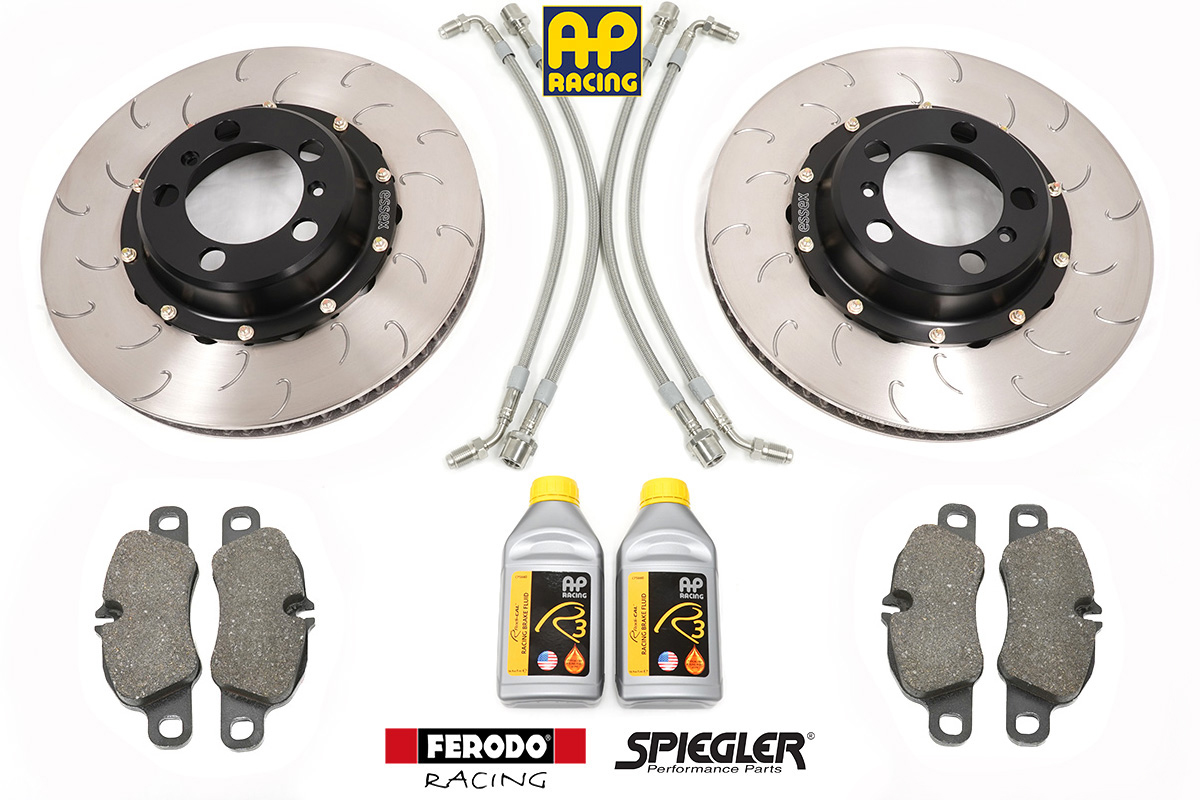
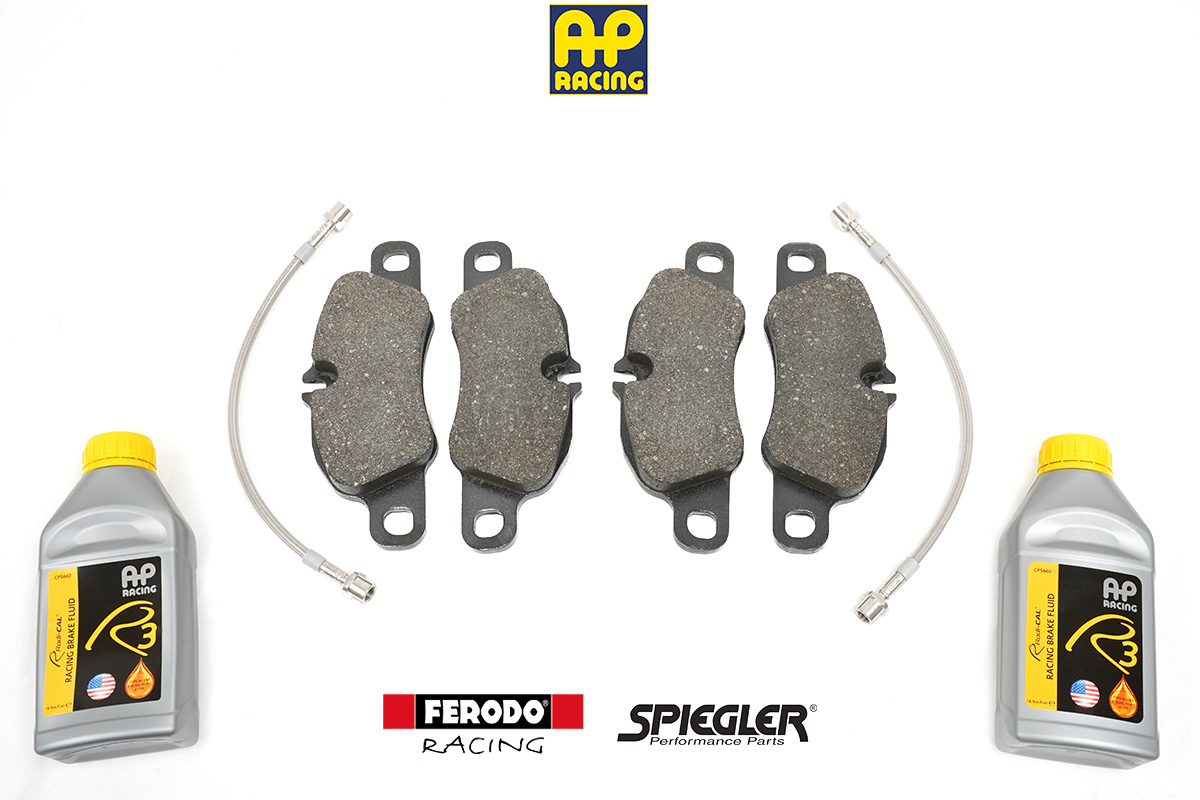
Caliper ‘Upgrade’- Something we see a lot in the Porsche market is owners taking the brake calipers and discs from a higher 911 trim level and trying to install them on a lower trim level. That practice started long ago when the 911 Turbo ‘Big Reds’ were being stuffed into the wheels of every other 911 variant. Going that route can be a recipe for problems and headaches. Even if the parts technically bolt onto your car’s suspension uprights, actual brake performance may suffer significantly and be worse than stock. The main reason for degraded performance is improper brake bias. For proper brake bias, the caliper piston sizes and brake disc effective radius must be appropriate for the vehicle on which they are being installed. With many modern 911 models, these components are not interchangeable. Not only can you run into a mess from a technical perspective, those who go down this path may need to scour and source parts from different suppliers, find them on the used market, etc. You’ll also have zero technical support for your brakes after choosing that path. If you want to upgrade both your calipers and your discs for AutoX, our suggestion is to choose a complete brake upgrade specifically designed for your Carrera T, rather than invading the Porsche parts bin. In a proper brake kit, the components are chosen specifically for the year/make/model/trim in question, and everything shows up in one box ready for installation.
Big Brake Kit / Complete Brake System- A complete brake system could be beneficial in AutoX for several reasons:
- Feel- Far stiffer, opposed piston calipers can offer dramatic changes in brake pedal feel and modulation vs. OEM calipers. Some highly competitive types will find the price of entry acceptable for this reason alone.
- Brake Balance/Bias- As noted above, achieving proper brake balance is very important for AutoX and is closely related to the feel point above. If the piston sizes and disc diameter are not chosen properly to match the brake master cylinder (we’re assuming you won’t be touching your OEM master cylinder), you will likely hurt your brake performance rather than help it. Increased (longer) stopping distances (the opposite of what you want!), long brake pedal travel, poor brake pedal feel, and hyperactive ABS intervention are just some of the potential negatives of a poorly engineered or implemented brake system.
- Unsprung Weight- Many complete brake kits shave weight over the stock setup. Even if the stock components and aftermarket components have the same physical dimensions, the aftermarket setup will be lighter 9 times out of 10.Weight-relieved aluminum calipers and aluminum disc hats are typically lighter than heavy OEM calipers and one-piece iron discs. As a bonus, the optimized components can offer a host of other benefits if you also track your autoX car. On the other hand, if you add components with extremely large discs and ten piston calipers to increase thermal mass/fade resistance (think 992 GTS or Turbo brakes), you may be adding unnecessary unsprung weight and rotational mass to the car, hurting your performance in autocross.
- Our most optimized AP Racing by Essex Radi-CAL Competition Brake Kit for Autocross would be the ones in the links below. Despite having considerably larger 372mm discs vs. the stock 330mm discs, and six pistons instead of four, our front brake kit removes approximately four lbs. of unsprung weight vs. the OEM front brake package. Our matching rear CP9449/365mm brake kit adds 35mm vs. the stock disc diameter but shaves five lbs. of unsprung weight! Our system also dramatically improves pedal feel, allows for much faster/easier pad changes, and offers far more autoX and track pad compound options. It also fits stock wheels and can fit inside aftermarket wheels as small as 18” (allowing for even more unsprung weight reduction and autoX tire choices).Our front and rear kits are available in two finish options, anodized and ENP (Electroless Nickel Plated).
- Front 991.2 Carrera T AP Racing By Essex CP9661/372mm Radi-CAL Competition Brake Kit (anodized)
- Rear 991.2 Carrera T AP Racing By Essex CP9449/365mm Radi-CAL Competition Brake Kit (anodized)
- Front 991.2 Carrera T AP Racing By Essex CP9661/372mm Radi-CAL Competition Brake Kit (ENP)
- Rear 991.2 Carrera T AP Racing By Essex CP9449/365mm Radi-CAL Competition Brake Kit (ENP)
- Front 992.1 Carrera T AP Racing By Essex CP9661/372mm Rad-CAL Competition Brake Kit (anodized)
- Rear 992.1 Carrera T AP Racing By Essex CP9449/365mm Rad-CAL Competition Brake Kit (anodized)
- Front 992.1 Carrera T AP Racing By Essex CP9661/372mm Rad-CAL Competition Brake Kit (ENP)
- Rear 992.1 Carrera T AP Racing By Essex CP9449/365mm Rad-CAL Competition Brake Kit (ENP)
- Our most optimized AP Racing by Essex Radi-CAL Competition Brake Kit for Autocross would be the ones in the links below. Despite having considerably larger 372mm discs vs. the stock 330mm discs, and six pistons instead of four, our front brake kit removes approximately four lbs. of unsprung weight vs. the OEM front brake package. Our matching rear CP9449/365mm brake kit adds 35mm vs. the stock disc diameter but shaves five lbs. of unsprung weight! Our system also dramatically improves pedal feel, allows for much faster/easier pad changes, and offers far more autoX and track pad compound options. It also fits stock wheels and can fit inside aftermarket wheels as small as 18” (allowing for even more unsprung weight reduction and autoX tire choices).Our front and rear kits are available in two finish options, anodized and ENP (Electroless Nickel Plated).
The AP by Essex Brake Kit described above (in anodized finish) installed on a 991 Carrera T
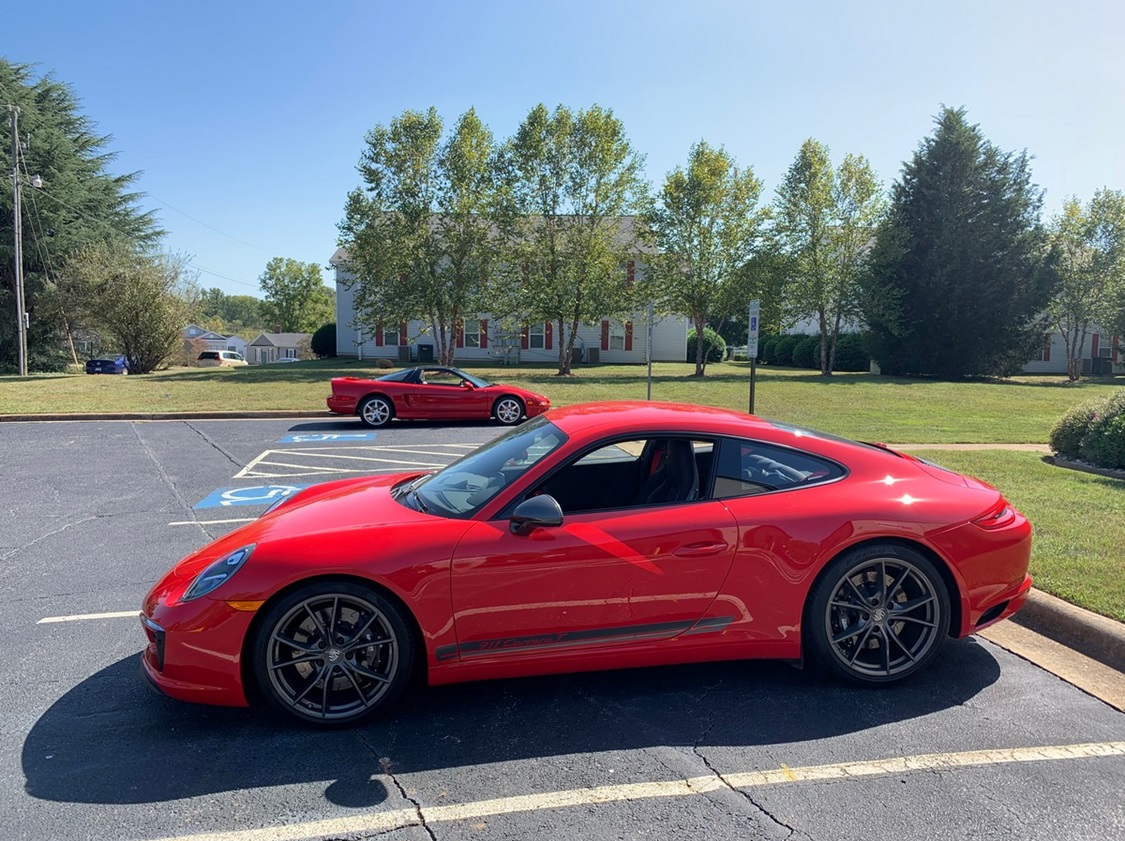
Our six piston CP9661 caliper weighs just over 6 pounds vs. 9+ lbs. for the OEM four piston.
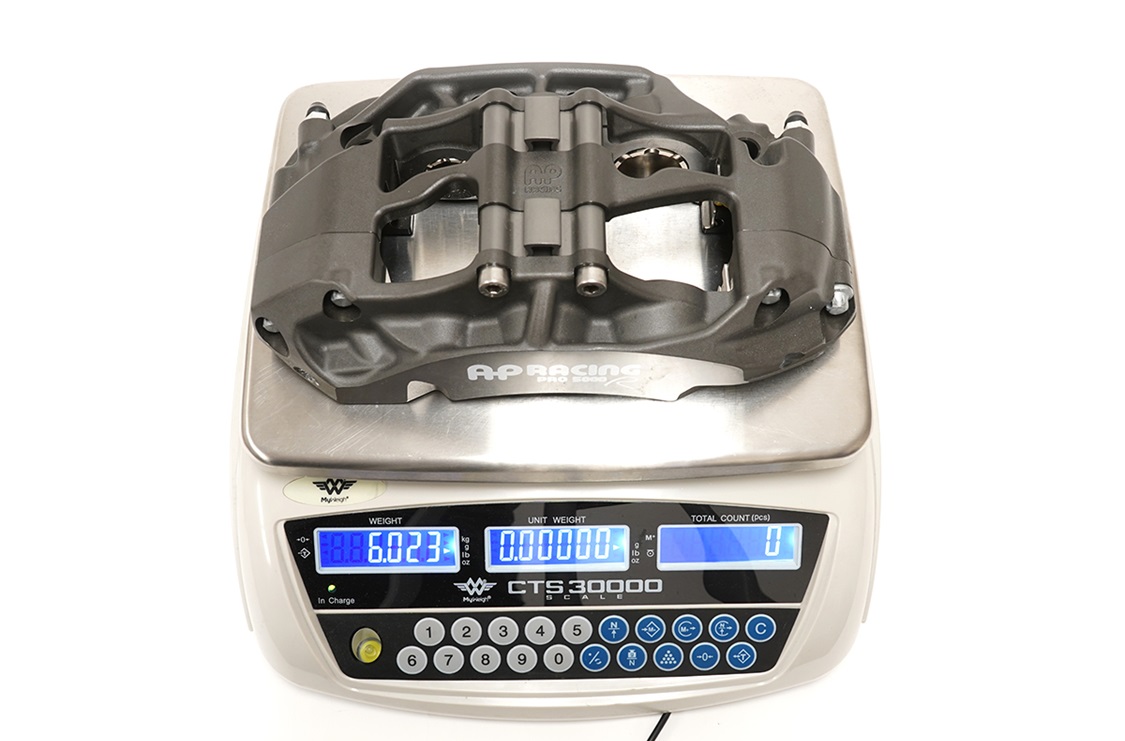
HPDE (High Performance Drivers Education) / Track Day / Time Trial / Time Attack
At a track day, you will always put more heat into your brake system than you ever will on the street or at an autoX. Please reread that sentence! Track Days are really the first venue mentioned thus far where battling heat becomes paramount for having an effective and reliable brake system. HPDEs typically have a diverse mix of vehicles being run, a wide range of speeds achieved, and vastly differing driver ability across run groups. As such, it's difficult to recommend a single blanket brake solution for a given vehicle driven at an HPDE. We will therefore preface the next portion of our brake recommendations with a brief look at some of the variables encountered at an HPDE or time trial.
After countless discussions with customers on this topic over many years, we believe there are a few critical considerations when upgrading your brakes for a Track Day or Time Attack. These factors will determine just how much thermal capacity your brakes will require:
Track layout
Tire choice
Vehicle modifications
Driving style and experience
A careful examination of these factors in your personal situation will help guide you towards the most appropriate brake solution. Keep in mind that all these factors are related and cannot be considered in isolation from one another.
Track layout
During a brake event, the rotational energy of the spinning discs is converted into heat and spread throughout your discs, pads, caliper pistons, caliper body, and brake fluid (as well as the surrounding suspension components via radiation). The faster the discs are spinning at the initiation of a brake event, the greater the amount of energy converted, and the greater the amount of heat that needs to be dealt with. Therefore, a track with long straights followed by tight turns generates the greatest amount of brake-related heat. The higher your terminal speed at the end of the straight, and the longer you are on the brakes to slow for a turn, the more heat you’ll be pouring into your brake components. When facing a series of long straights followed by tight turns, the issue is compounded even further. The temperature rise on your brake components is both dramatic and rapid during each intense brake event; then the components are immediately doused with cooling air during the subsequent lengthy straight. These rapid temperature swings are what cause the most stress-related brake issues, not necessarily the absolute temperature the brakes reach.
The distance between stops also dictates how much heat is retained in your brakes. If a track layout has a steady succession of medium straights and tight turns (think Carolina Motorsports Park), your brakes might not reach the same max temperature as they would on a track with longer straights, but they won't have much time to cool between stops, creating heat soak. Flowing tracks with long sweepers are much easier on brakes (i.e. Willow Springs or Roebling Road).As noted above, tracks with very long straights followed by tight turns are the most devastating to your brakes (Watkins Glen, Road America, Circuit of the Americas). A close look at the track(s) you'll be regularly driving will help determine just how much stress your brakes will need to endure, how much thermal mass you should seek in your brake discs, and how much fade resistance your pads and fluid will require.
Tire choice
Brakes don’t stop your car, your tires do. Brakes convert the kinetic energy of the spinning discs into heat, but the tires generate friction with the track surface and actually slow the car. Tire choice has a large impact on how much brake your car can leverage, and how much heat will be generated by your brakes. The stickier the tire, the more brake you can leverage, the shorter your stopping distances will be, and the more brake heat you will generate. More grip = more heat. If you're running low grip all-season tires, or if it rains at an event, your tires won't be able to generate as much friction with the track surface, and you therefore won't tax your brakes as much.
Vehicle mass and horsepower
All else held equal, more massive, more powerful cars place a greater strain on their brake system. A Corvette ZR1 will generally require a much larger pad and rotor as a heat sink vs. a Miata. That is partly because of the mass, and partly because of the horsepower. What may surprise you, however, is that the speed component has more impact on your brake requirements than mass does. Higher speeds increase brake demands at an exponential rate, while adding mass increases brake demands at a more linear rate. If you strip 200lbs. out of your car (easier to accelerate), have a quality coilover system (higher cornering speeds), and add 40hp (greater acceleration out of turns), you may be placing less demand on your brakes in terms of vehicle mass, but you'll need to slow the car from higher speeds when entering brake zones. While it may be counterintuitive, the car might be tougher on your brakes despite its reduced weight (Again, outside the scope of this article, but to learn more on this topic, please research the formula K.E. = 1/2 m v2). Again, the relevant point to this discussion is that more massive, more powerful vehicles require larger, more durable brake components, and anything you do to your vehicle to alter its power output or weight will impact your brake requirements.
Driver experience
If you've never driven anywhere but the street, your first couple of trips to the track will most likely not tax your brake system too heavily, right? Not exactly. You being a complete track newb won't necessarily protect your stock brakes from total destruction. Novice drivers may be easier on the brakes for several reasons: Their corner exit speeds are lower, their terminal speeds entering brake zones are therefore lower, and there's less kinetic energy being transferred into heat during a given stop. That said, novice track drivers also tend to stab wildly at the brakes, stay on the brakes far too long, oscillate between on and off brake, and inflict all sorts of brake abuse a pro driver would never do! The result can be some serious brake punishment. It's therefore impossible to make a blanket statement that a novice driver will be fine on stock brake pads. Reality has proven that statement false countless times, particularly on the faster, heavier cars our customers often take to track days.
So where do these factors leave us when upgrading our brakes for a Track Days, HPDE, or Time Trial? The critical point is, every modification you make to your car and the nut behind the wheel will change the demands on your brake system, and you must adjust accordingly. Just because you successfully used a certain pad compound before, doesn't mean it will work again after you've installed bigger turbos and Hoosiers. Chances are that after your 25th HPDE, you'll be taxing your brakes in a different manner than you did during your first event. You'll be hitting higher speeds, entering and exiting corners faster and on a different line, and your car will likely have more grip and power than it did when you started (you'll also likely be much poorer, but happier!). If you typically run Limerock Park (a short track without many big braking zones) but decide to make a trip to Road America (a crazy fast track with huge brake demands), you need to reconsider how your brakes will be taxed. You must constantly evaluate the overall capabilities of your brake system, and not be afraid to try new brake setups as both you and your car evolve.
Finally, if you want to play it safe and not risk damage to the major components of your brake system, don't EVER drive an OEM brake pad on a road course. It may be more convenient and seem economical to run stock pads, but it will eventually cost you time and money in the long run. There's also not much worse than wasted track time. When you're sitting in the pits watching your buddy rip down the front straight, and your stock pads are a steaming pile of dust stuck to the inside of your wheels, you'll be wishing you spent a couple hundred bucks and took the hour on Friday night to change your pads and bleed your brake fluid! Please read this article on the Essex Blog for even more reasons not to run your OEM pads on the track: “Can I Run my OEM Brake Pads on the Track?”
Now that we have a better understanding of how taking our car to the track impacts our brake system, let’s look at track-specific brake upgrades for the Carrera T:
Track/Racing Brake Pads- Having dedicated track pads with a high max operating temperature is an absolute must for running your car on the racetrack. Road pads melt, smear, fade, crumble, incinerate and simply can’t handle the heat associated with repeated lapping. Our two favorite pure racing pad compounds are the Ferodo DS1.11 and DS3.12.Some people get away with the Ferodo DS2500 when running them in our complete brake systems, but we’d advise sticking with the other two options instead. For a closer, more detailed look at the Ferodo compounds, please read our article, “Which Ferodo Brake Pad Compound is Right for Me?”
991.2 and 992.1 Carrera T front Ferodo DS1.11
991.2 and 992.1 Carrera T rear Ferodo DS1.11
991.2 and 992.1 Carrera T front Ferodo DS3.12
991.2 and 992.1 Carrera T rear Ferodo DS3.12
Racing Brake Fluid- Proper racing brake fluid is a cheap and easy upgrade that should be considered an absolute must for track work. Many Porsche enthusiasts have been sold on the idea that a brake fluid’s ‘wet boiling point’ is crucial for track use. That may have been the case at some point long ago, but really isn’t relevant in any discussion of modern brake systems. These days a high ‘wet boiling point’ is simply a buzzword. The calculation for wet boiling point assumes that a modern vehicle’s brake system has absorbed far more water than it ever could or would within any reasonable amount of time (3.7%). Older systems, and many racing dual-master cylinder systems with a balance bar, had/have vented reservoir caps with open vents, which do not keep the outside air separated from the brake fluid. However, all modern OE master cylinders on road cars have reservoirs with bellows, which do a fantastic job of keeping air and moisture out of the fluid. Will your brake fluid still absorb some water? Of course! You may open the reservoir cap every now and then to top off your brake fluid. But, if you only leave the cap off for the few minutes required to bleed your brakes twice per year, 0.5% is a more realistic water content for your brake fluid. Since your brake fluid is unlikely to ever reach a 3.7% water content, the wet boiling point test standard is rendered irrelevant, and would likely be more applicable to a road car with a vented cap that has never had its brake fluid changed…a situation that is unlikely to occur. Therefore, a brake fluid’s dry boiling point is the much more relevant data point for a properly maintained, modern road car brake system with a reservoir cap that has bellows. For more details on this topic, please see our article, “How to Choose Racing Brake Fluid”.
Our fluid recommendation is one of AP Racing’s Radi-CAL line of fluid or Ferodo Super Formula Racing Brake Fluid. The AP line comes in several varieties. For a 911 on the racetrack, we would suggest focusing on AP Racing R2, R3, or R4.If you’re running OEM calipers, pad shapes, and discs, your brakes are going to be running hotter and we would suggest R3 or R4.If you’re running Essex/AP Racing 2-piece J Hook Discs or one of our complete brake kits (which run significantly cooler than OEM brake components), we’d suggest R2 or R3, and only moving to R4 if you had evidence of fluid boil (which is incredibly unlikely).
- Note- A common question we receive is, “If I upgrade to your 2-piece J Hook Discs that mate to my stock calipers, will I later be able to add the AP Racing calipers? ”The answer is unfortunately, “No”. The AP Racing Radi-CAL calipers run on discs of different dimensions vs. the stock calipers. One of the biggest differences is that the radial depth of the AP and OEM discs are considerably different (radial depth is the height of the disc face…the difference between the outer diameter and inner diameter).To learn more about why discs aren’t easily interchangeable, please watch our video, “Will the Brakes From a Different Car Fit my Car? "Again, if you choose 2-piece brake discs to mate with the OEM calipers, and later decide that you want a complete brake kit, you will need to essentially start over and buy the complete brake kit , including the new discs designed to mate with the AP Racing calipers.
- The next logical question then becomes, “Will your 2-piece discs be enough for me, or should I go with a complete brake kit?”That depends completely on your car and how you plan to drive it. Our earlier discussion about modifications, tracks being driven, etc. all factor into how much brake heat capacity you will require. If you plan to stay at stock power, on street tires, running a relatively easy braking track, and you tend not to be terribly hard on brakes, then 2-piece discs may be ample for your needs. If you plan to do a Stage 2 tune, run racing slicks, frequent Watkins Glen, and you tend to be hard on brakes, a complete big brake kit will be a much more appropriate option to provide you the fade resistance and durability you’re likely seeking. If at any time you want more personalized recommendations for your specific needs and situation, we will be happy to guide you through this process based on our prior experience with thousands of Porsche clients.
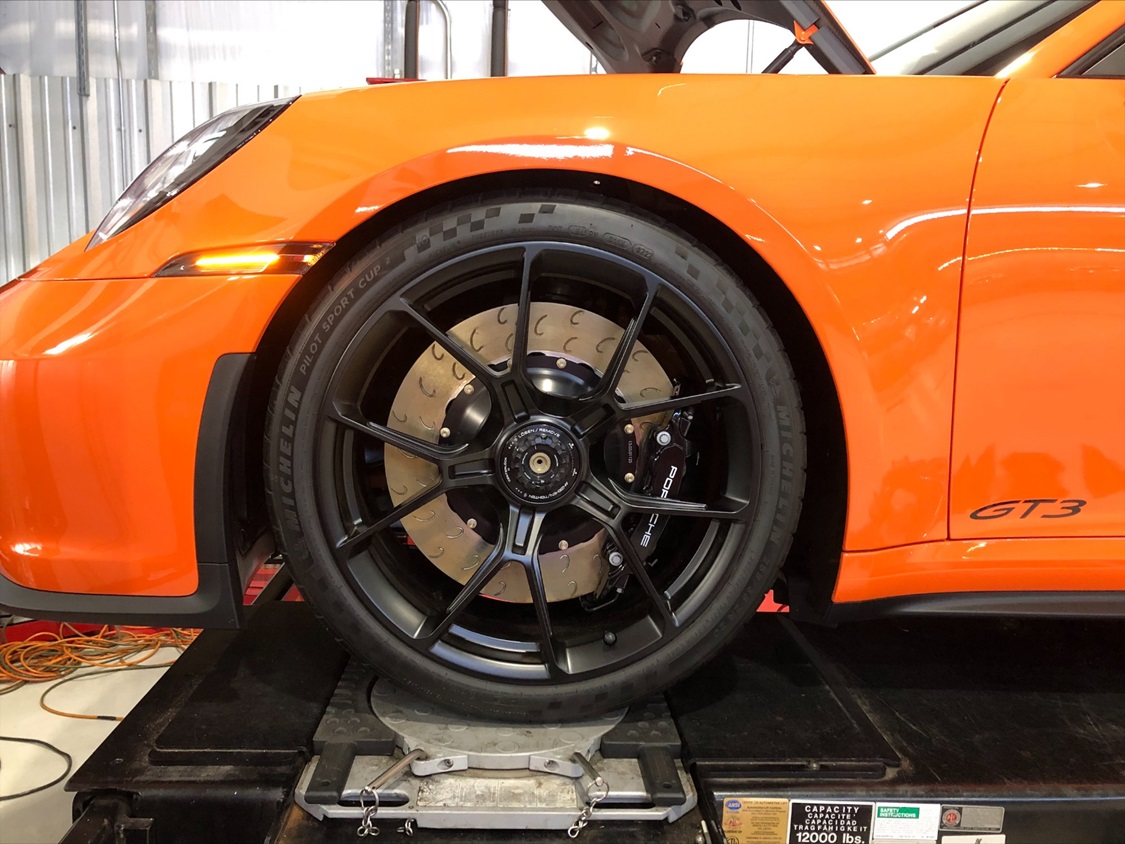
-
Big Brake Kit / Complete Aftermarket Brake System- A complete big brake kit is a giant leap forward in brake performance and capability vs. 2-piece discs mated to stock Porsche calipers. While the discs play an important role in managing brake temperatures, aftermarket calipers can provide a wide array of invaluable benefits as well. Superior pedal feel due to increased stiffness, a considerable reduction in unsprung weight, not having to remove the calipers to change pads, a greater array of pad choices, ventilated stainless pistons that keep heat out of the brake fluid, anti-knockback springs to retain a high, firm pedal…the list goes on and on. The AP Racing Radi-CAL is the lightest, stiffest, most advanced brake caliper design on the planet, period. Its introduction rocked the professional racing world over a decade ago, and it has become the gold standard against which all other brake calipers are measured. The AP Racing Radi-CAL has won numerous 24 hour races on Porsche factory racecars, and Porsche even chose to implement them on their latest GT3 R factory racecar.
- Essex offers two main types of AP Racing Brake Kits, Road and Competition. How you plan to use your car will determine which brake kit type will best suit your unique needs. I like to think of our two brake kit types as our hammer and our scalpel. The Road Kit is the hammer. The discs, calipers, and pads are all larger and heavier than their Competition counterparts. Our Road Kits combat brake heat through sheer mass, while providing a few additional road-friendly features vs. our Competition Kits, like dust boots and a painted caliper finish. Our Competition Kits are the scalpel. They solve the brake heat dilemma through clever design and advanced materials, rather than sheer mass. We created this handy guide to outline the fundamental differences between our two types of brake kits: “Which Type of AP Racing Brake Kit is Right for Me?”
- Even though all our brake kits are technically designed for ‘Off-road use only,’ many of our Road Kit clients use their brakes on the racetrack, while numerous Competition Kit owners also drive their dual-purpose road/track cars on the street. There are no inherent design feature in either type of brake kit that would preclude them from being run in the environment of your choosing. How well each kit will perform on the road or track largely depends on the type of brake pad that is installed at any given time.
- On the 911 Carrera T, we’ve had quite a few owners choose both types of kits. Those who normally only run a couple track days a year, spend most of their time on the street, drive their cars through the winter, or simply want something to fill their wheels out better choose our Road Kits. Our clients who spend more weekends at the track, are looking to shave the most weight, or want to run smaller, lighter wheels tend to choose our Competition Kits.
- AP Racing by Essex Radi-CAL Road Kits- Our Road Kits are similar in size to the factory brakes from a 991 or 992 911 GT3.The front calipers are large six piston Radi-CAL units mated to heavy-duty 380x36mm, 72 vane AP J Hook Discs, while the rear four piston calipers cover 380x28mm discs. The pads in the fronts and rears have a large swept area and can hold a lot of heat .Our Road Kits provide a huge increase in fade-resistance and durability, as well as a dramatically improved aesthetic vs. the puny OEM 911 Carrera T brakes! If you mostly drive your T on the street but want the capability of hitting the track on occasion, our Road Kit is a fantastic choice. One of the greatest benefits of our system vs. trying to piece together OEM Porsche parts from other trim levels is that our kits are designed to maintain proper brake bias on our vehicle. Our kit also comes with everything required for install in one box, including a set of the phenomenal Ferodo DS2500 brake pads. You won’t need to research, chase parts from different vendors, hope that everything goes together properly. You can also expect lifetime product support from our highly trained staff.
- With all our front Comp Kits you’ll have two front caliper options, the CP9661 or the CP9669. The narrower CP9661 uses an 18mm thick pad and offers superior wheel fitment (fits stock wheels without a spacer). The CP9669 calipers use a beefy, 25mm thick pad which dramatically extends pad life, but has a tougher time fitting behind certain wheels. Please see our article, “Sibling Rivalry: Which AP Racing Radi-CAL is Right for Me?” for detailed guidance on choosing between our two front caliper options.
- Our Competition Kits also come in two caliper finishes, anodized and electroless nickel plated (ENP). We now have clients with anodized Pro5000R Radi-CAL calipers that have been in service for close to ten years that are still in great condition and running strong (most without any rebuilds). The ENP finish simply ratchets the durability up one notch further, as described in this blog post from when we introduced ENP to the enthusiast community in 2022.
- Once you have decided which AP caliper width and finish you prefer, your next choice is disc size. We offer one kit with larger discs, and one with smaller discs. Please note that once you choose a disc size, you cannot later change your disc size. For example, you cannot purchase our rear 365mm kit, and later decide that you want to run our larger rear 380mm discs. The rear calipers have different piston sizes depending on which disc size you choose, and the caliper brackets and disc hats are all completely different in the two kits and are in no way interchangeable. Once you have chosen a kit size, you have no options to change your disc size on the front or rear, so please take your time and choose wisely! Also, the larger front 390mm kit should be paired with our larger rear 380mm kit, and our smaller 372mm front should be paired with our smaller 365mm disc kit. Which disc size you choose should be determined by:
- How much thermal capacity you want/need (based on your modifications, intended tracks, driving style, etc. as discussed above). Our larger 390x36mm discs are considerably more durable than the 372x34mm discs, which are immensely more durable than the OEM 330x34mm discs. The downside to the larger 390mm discs is that they are slightly heavier than the 372mm discs. However, the largest 390x36mm discs still only weigh about the same as the OEM 330x34mm discs, despite the huge size difference!
- What size wheels you plan to run. Our 372mm disc kits can fit inside wheels as small as 18”, but our 390mm
disc kits generally won’t fit in anything smaller than a 19” wheel.
- “So, should you go larger or smaller?” If you aren’t worried about shaving every ounce of unsprung weight, you discover that our 390mm discs will fit the wheels you intend to run, you want the greatest durability out of your discs, and plan to add a huge slug of horsepower to your car while driving tracks that punish brakes, choose our larger disc option. If you want to gain considerable thermal mass while still shedding as much unsprung weight as possible, and want to run the smallest, lightest weight wheels possible, our 372mm kit would be your choice.
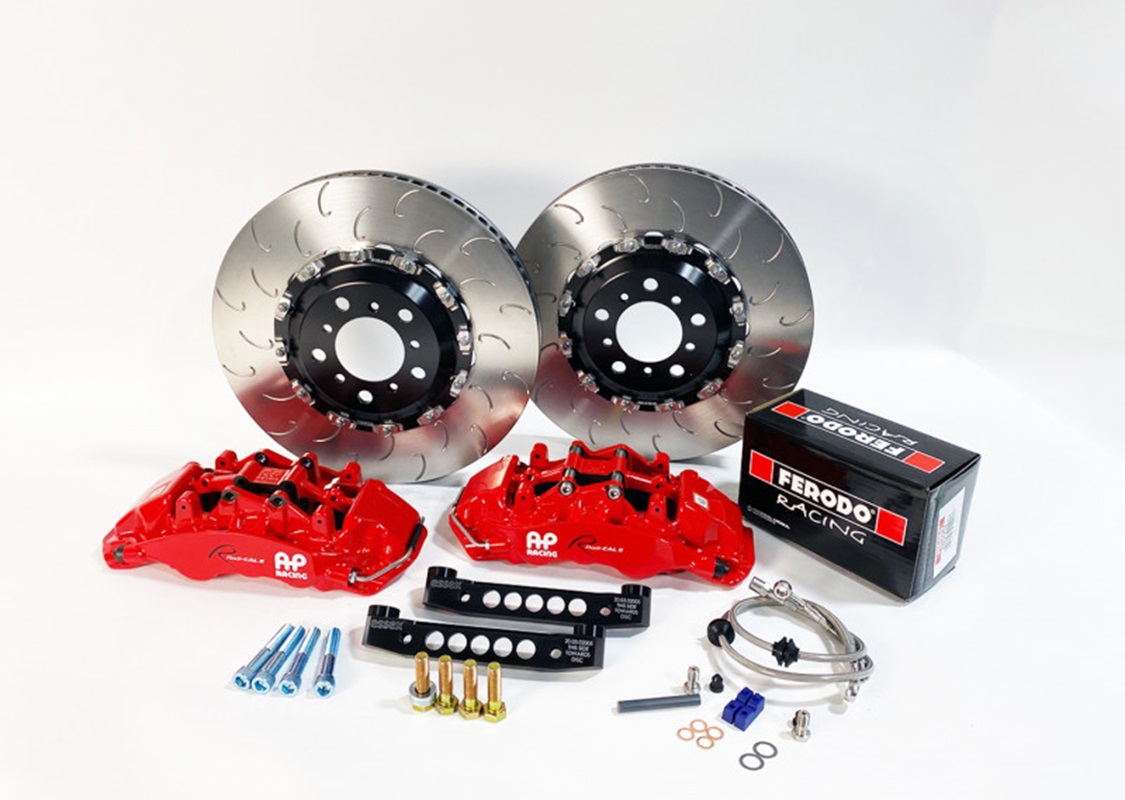
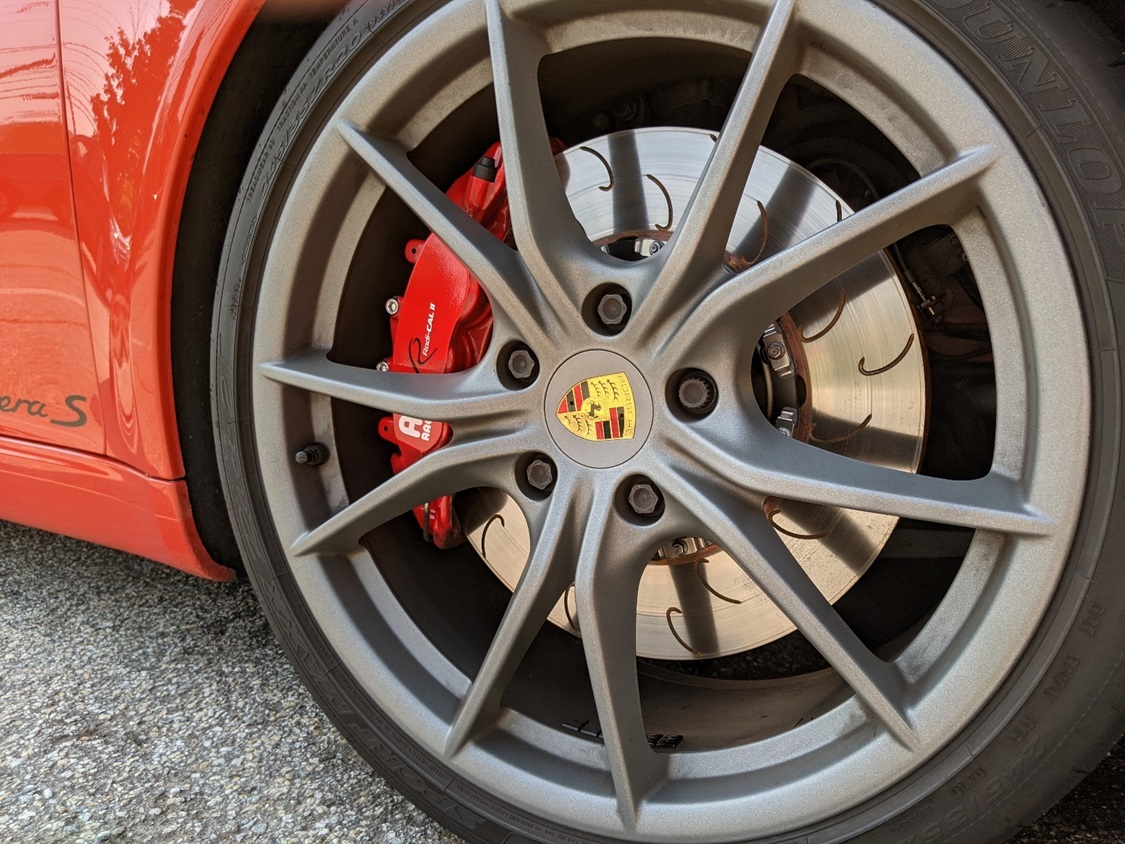
Road Kits are available with black, red, or silver painted World Radi-CAL II calipers
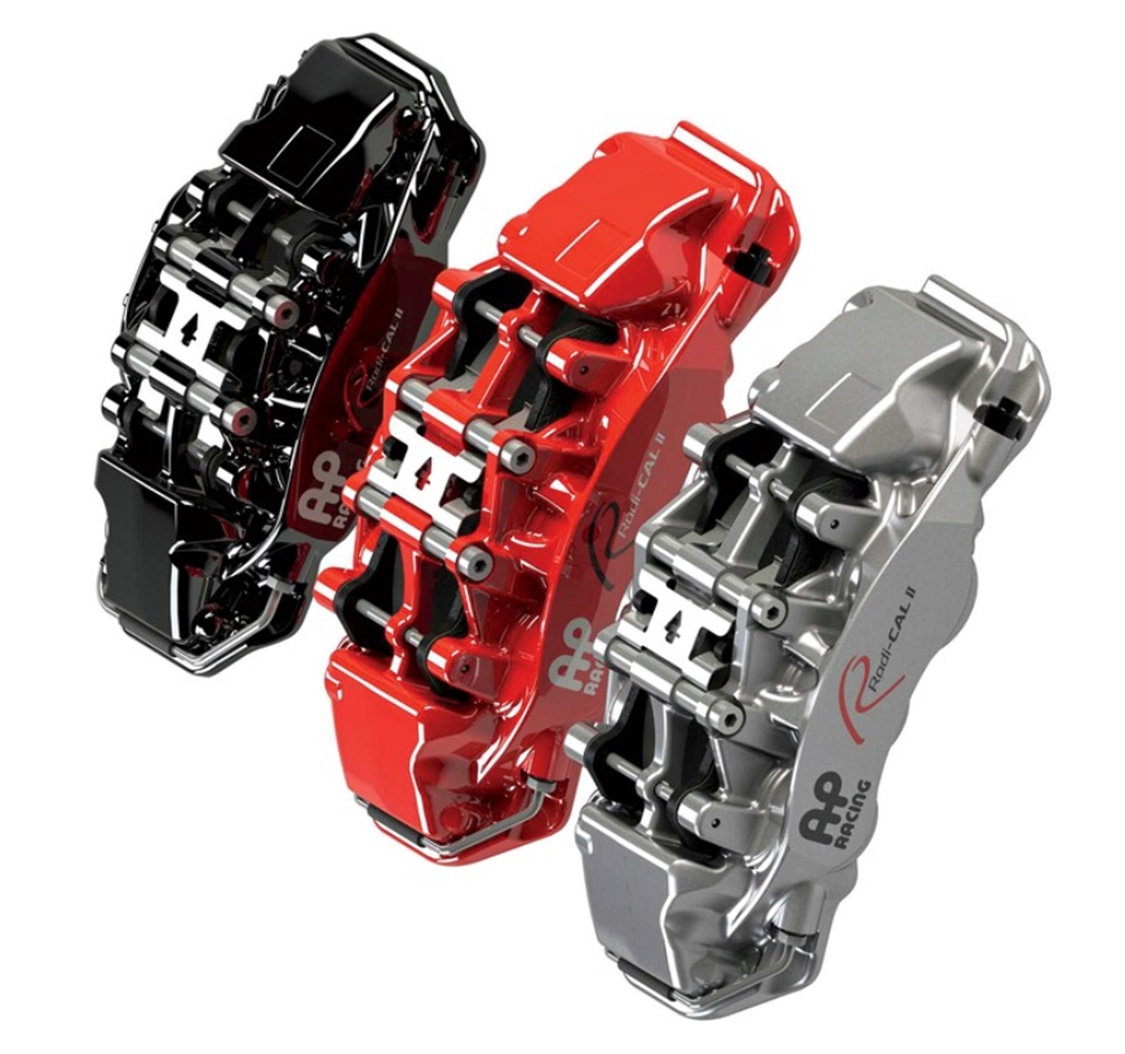
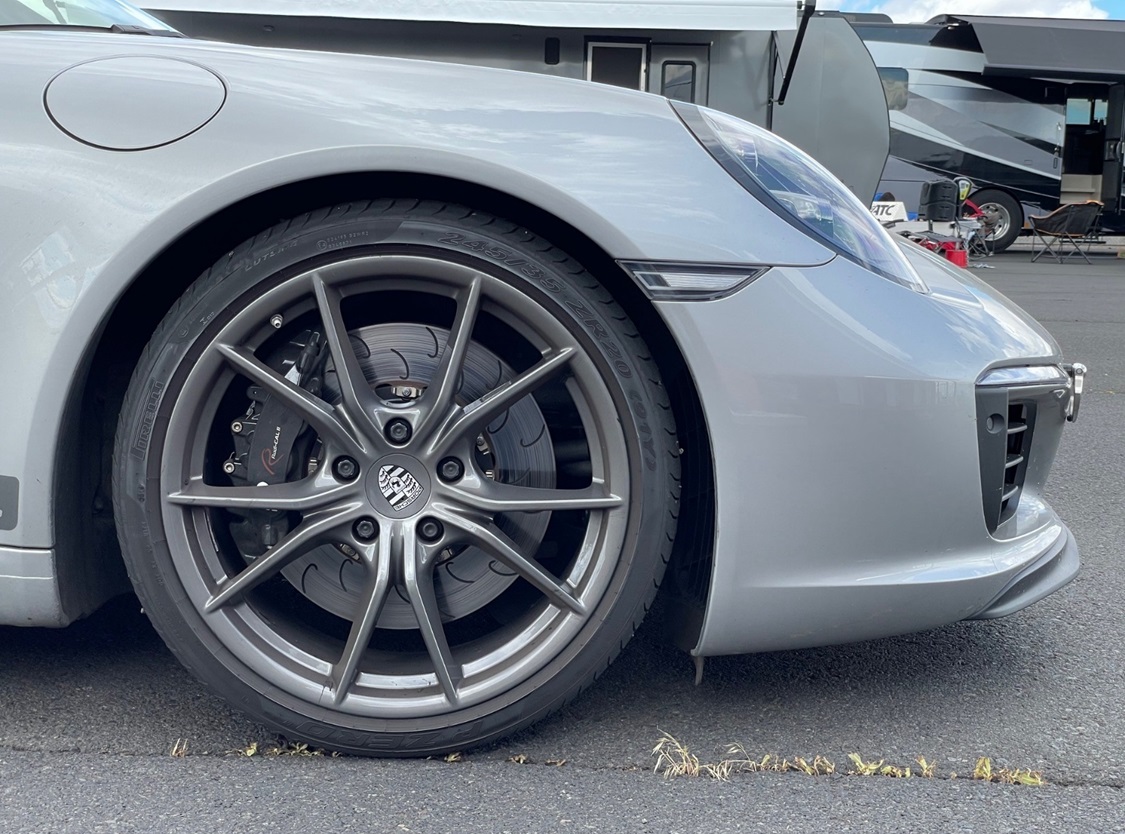
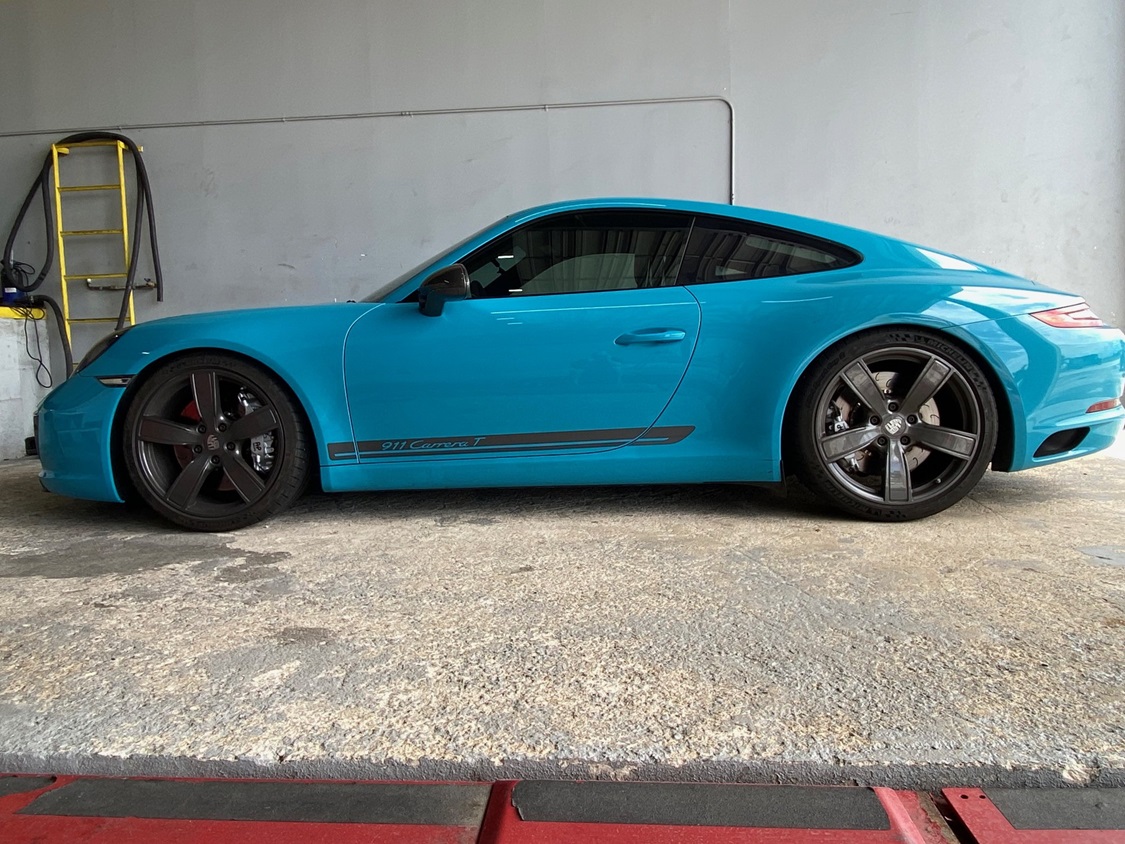
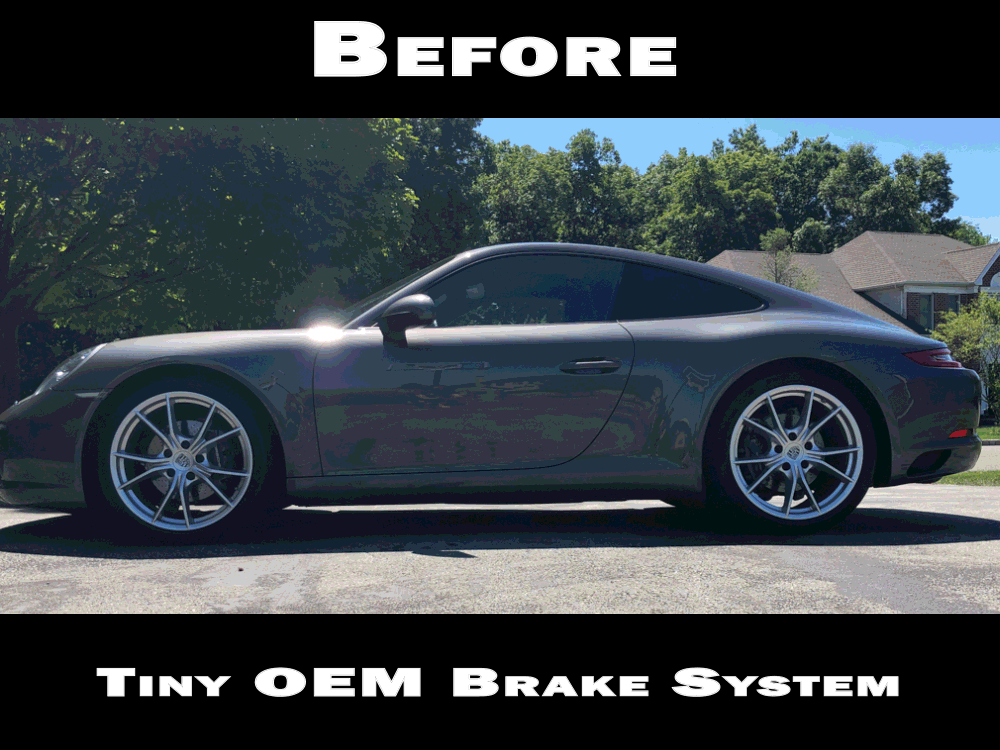
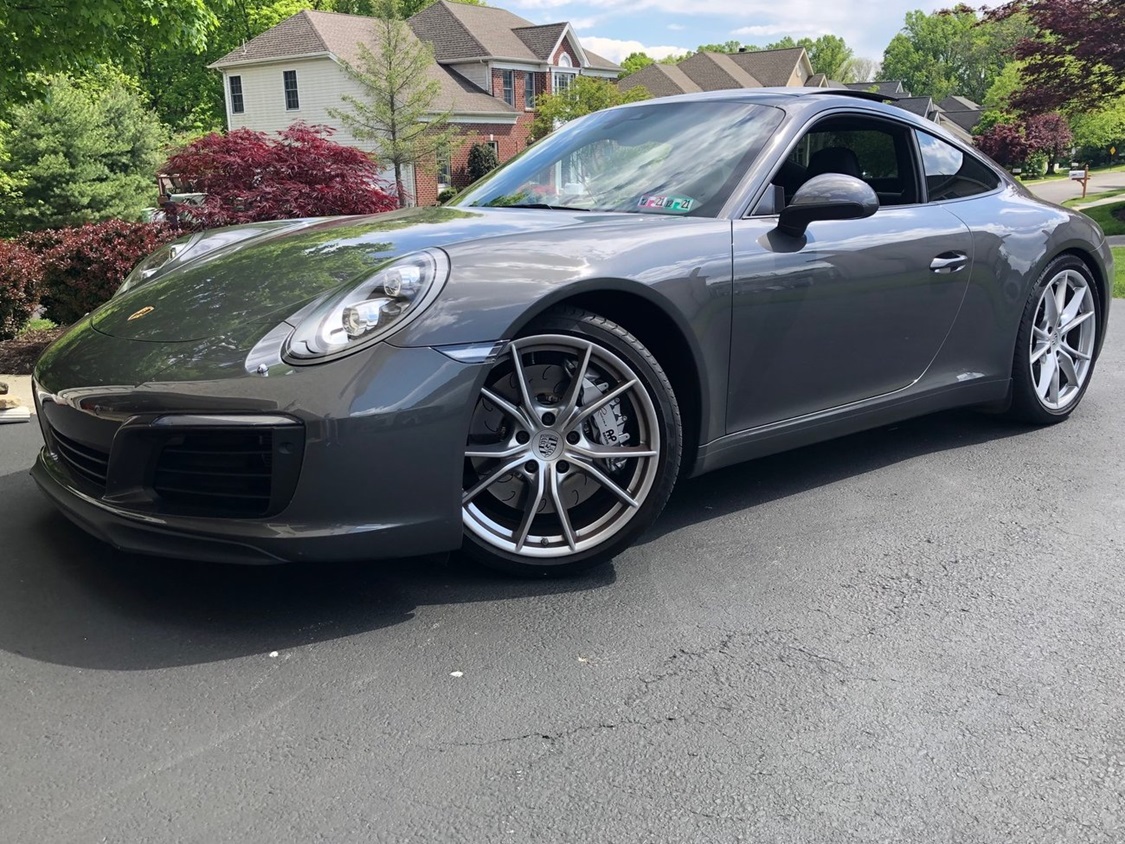
AP Racing by Essex Radi-CAL Competition Kits- Our Radi-CAL Competition Kits come in a couple different sizes and configurations, and your correct choice will depend on how you intend to modify your car, and how and where you’ll be driving it.
Wheel fitment- Regardless of which kit you’re considering, it is important to ensure that our system will clear every wheel set you intend to run. Essex publishes a downloadable wheel fitment template for every brake kit we offer. Please watch this video for instructions on how to find the wheel template for any brake kit you’re considering. Then watch this video about how to use our wheel templates.
Complete Brake Kit Value and Long-term Running Costs: Let’s face it, our complete brake kits aren’t cheap! That said, they are an extremely good value with a fantastic ROI. One of the best features of our brake systems is that they hold their value incredibly well due to their durability, serviceability, and AP Racing's stellar reputation as a top supplier. Our brake kits typically change hands on the used market for about 65-70% of what they cost new. If you spend roughly $11k on our four-wheel kit, you'd typically expect to get $6,000-$7,000 back when you sold them used. That means you can buy them, beat them up for years, sell them for thousands of dollars, and still have your fresh OEM brakes sitting in your garage, ready to drop on your car when you're ready to sell it. That is absolutely not the case with OEM brake equipment, or aftermarket brake discs alone. The aftermarket calipers retain a great deal of value.
Carbon Ceramic Discs- OEM PCCB brakes were an $8,000 option on the 991 T, and not even an option on the 992.1 T. If you track your car, all real-world evidence tells us that you will most assuredly destroy PCCB discs in a reasonably short time (relative to iron discs).Spare replacement PCCB discs are also more expensive than the original purchase price of the complete PCCB brake system as a factory option! The only reason to even consider PCCB, or any carbon ceramic discs for that matter, is if you have a life-threatening aversion to brake dust. Otherwise, our AP Racing by Essex Brake Kits offers a similar (and sometimes lower) initial purchase price which includes the best brake calipers in the world, immensely lower long-term running costs, and a much higher resale price on the used market when it comes time to move to your next car. Our kits are also nearly as lightweight as carbon discs mated to the OEM calipers, because our AP Racing Radi-CAL calipers are so much lighter than stock.
Conclusion
Regardless of how you plan to use your 911, there are a wide variety of brake upgrades available. You can keep it cheap and simple, or you can completely replace the entire OEM brake system in favor of something far more appropriate for the heaviest track abuse imaginable. Regardless of which route you choose to pursue for a brake upgrade, Essex has you covered!
Please visit the Essex Blog for a wide variety of Porsche owner reviews
of our various brake products. Many times, reading their stories can be
quite beneficial in determining which products might work best in your
unique situation.
Racing brake pads are a personal choice, and not included with AP Racing by Essex Competition Kits. We do however, offer I highly discounted first set of Ferodo Racing pads with a brake kit.
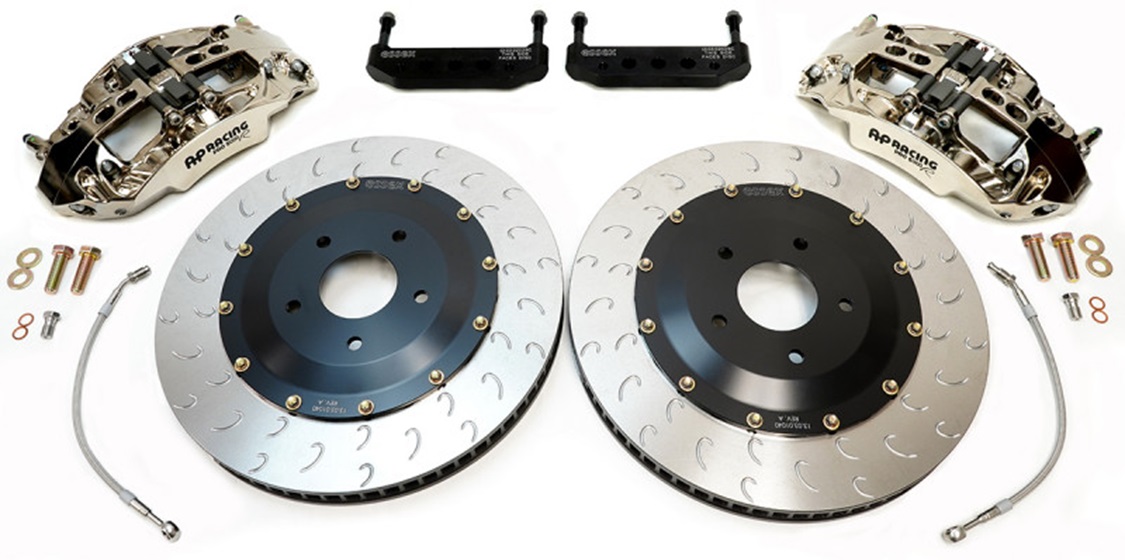
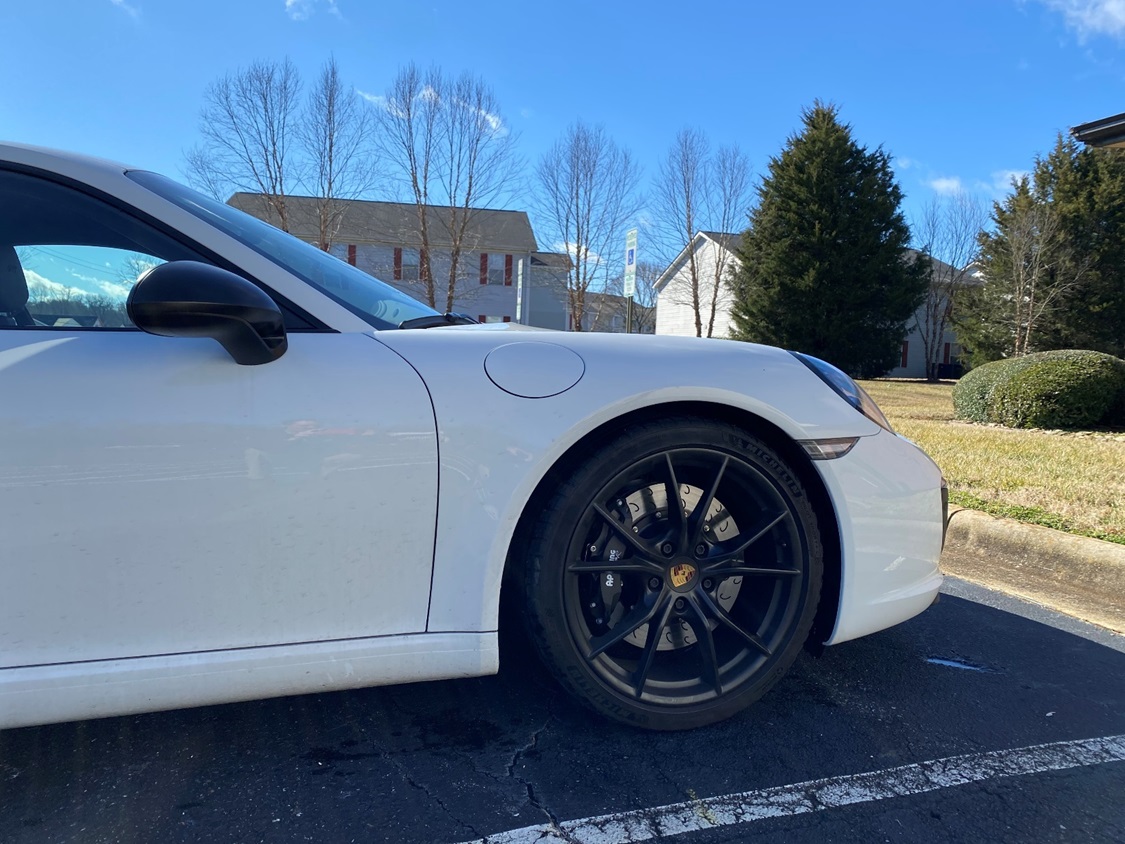
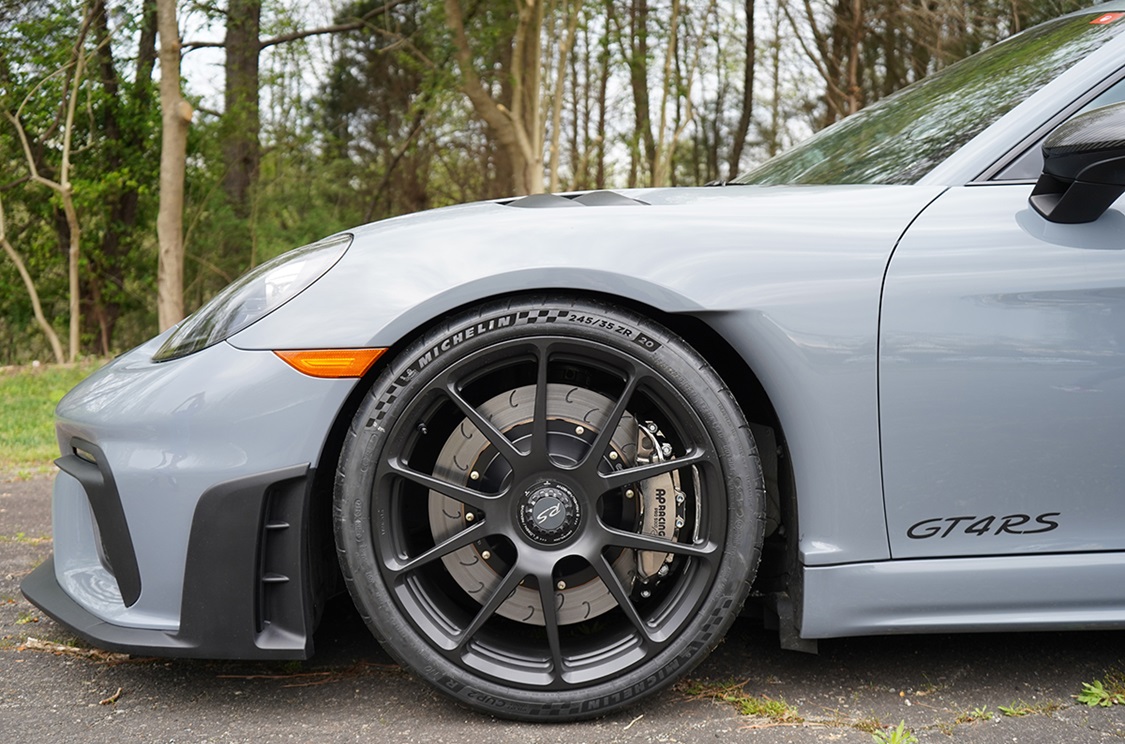
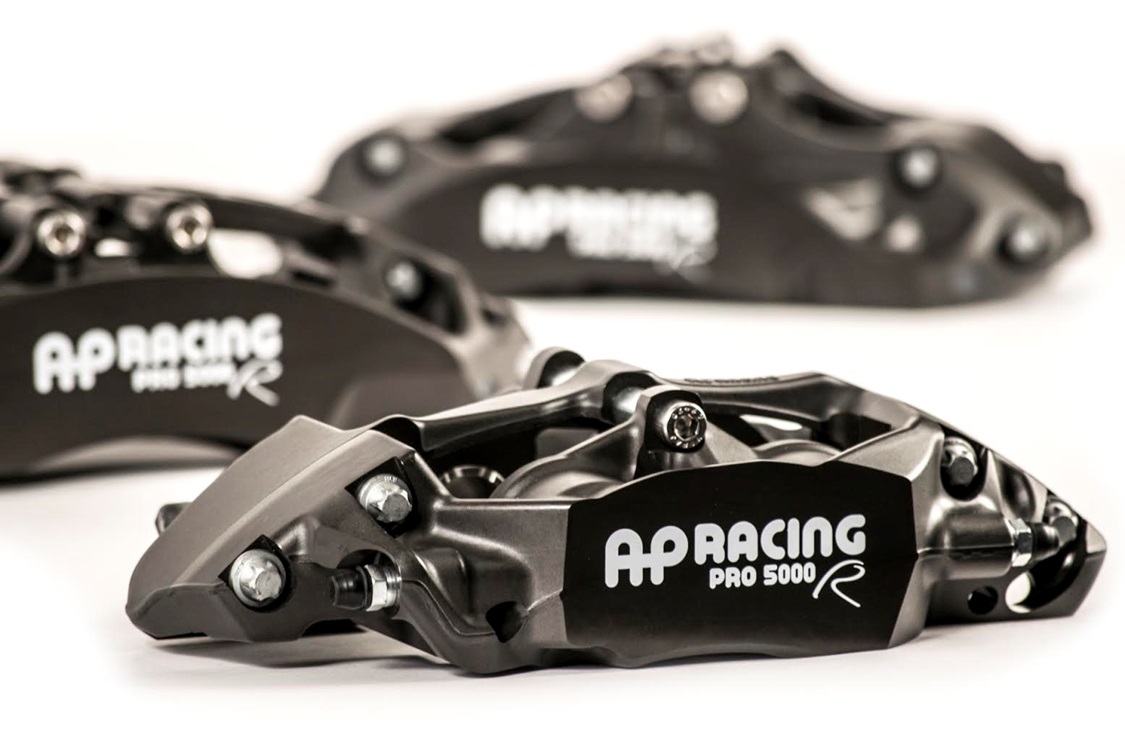
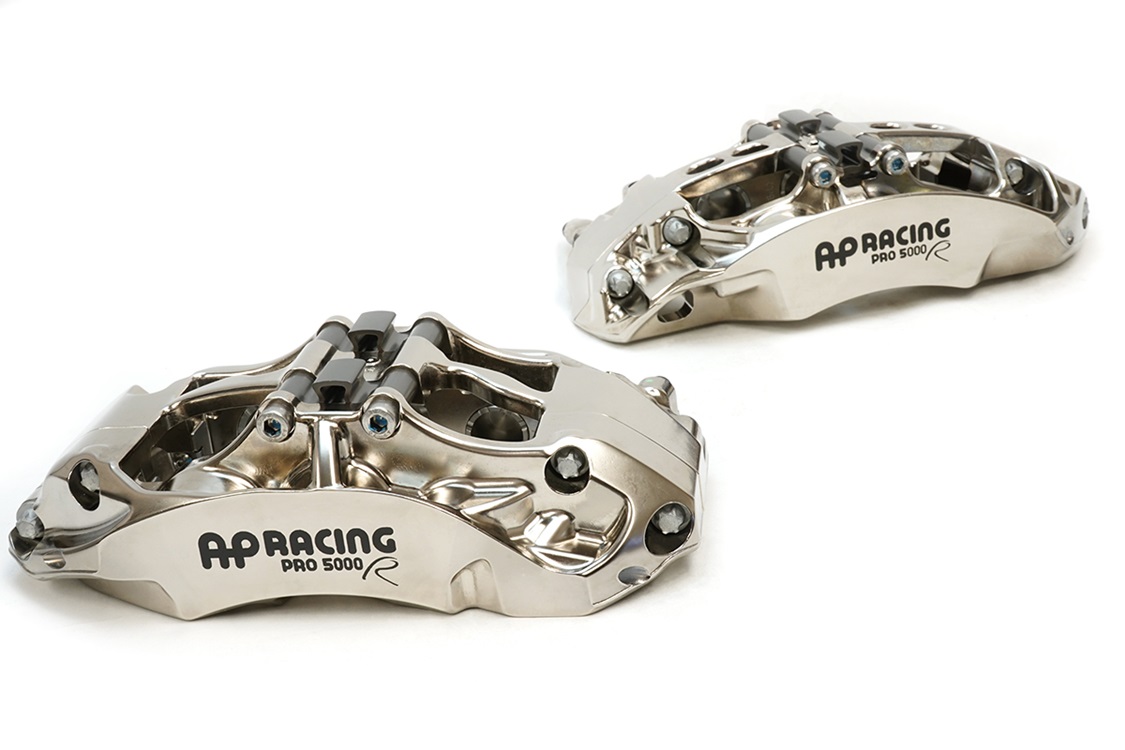
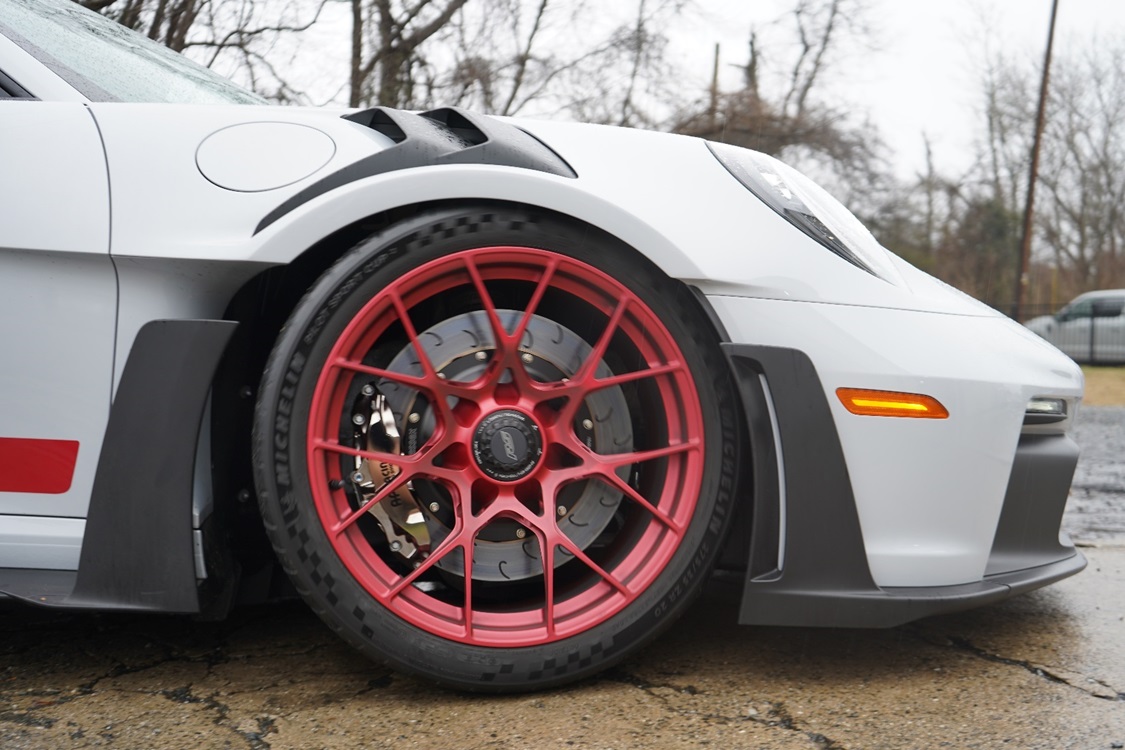
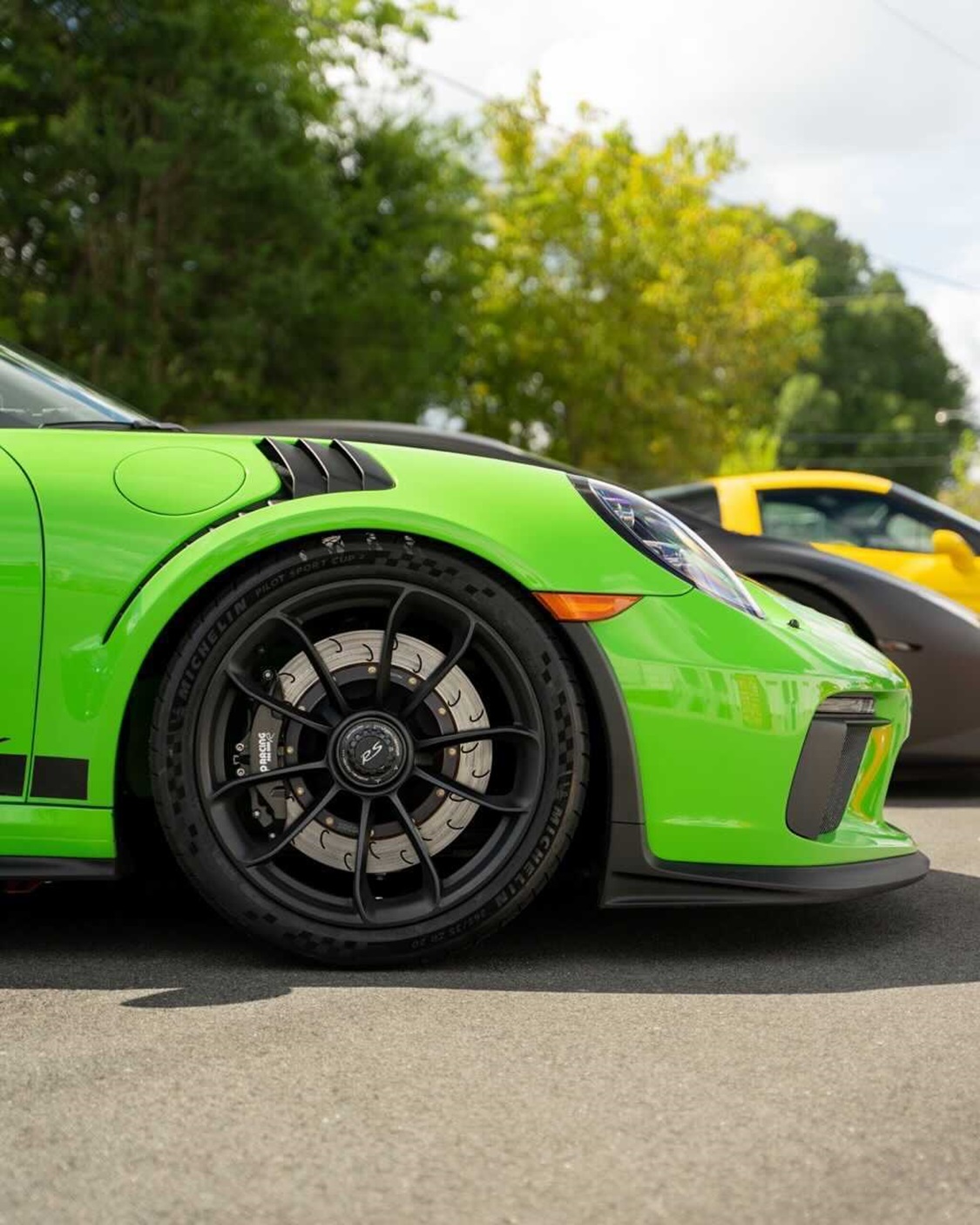
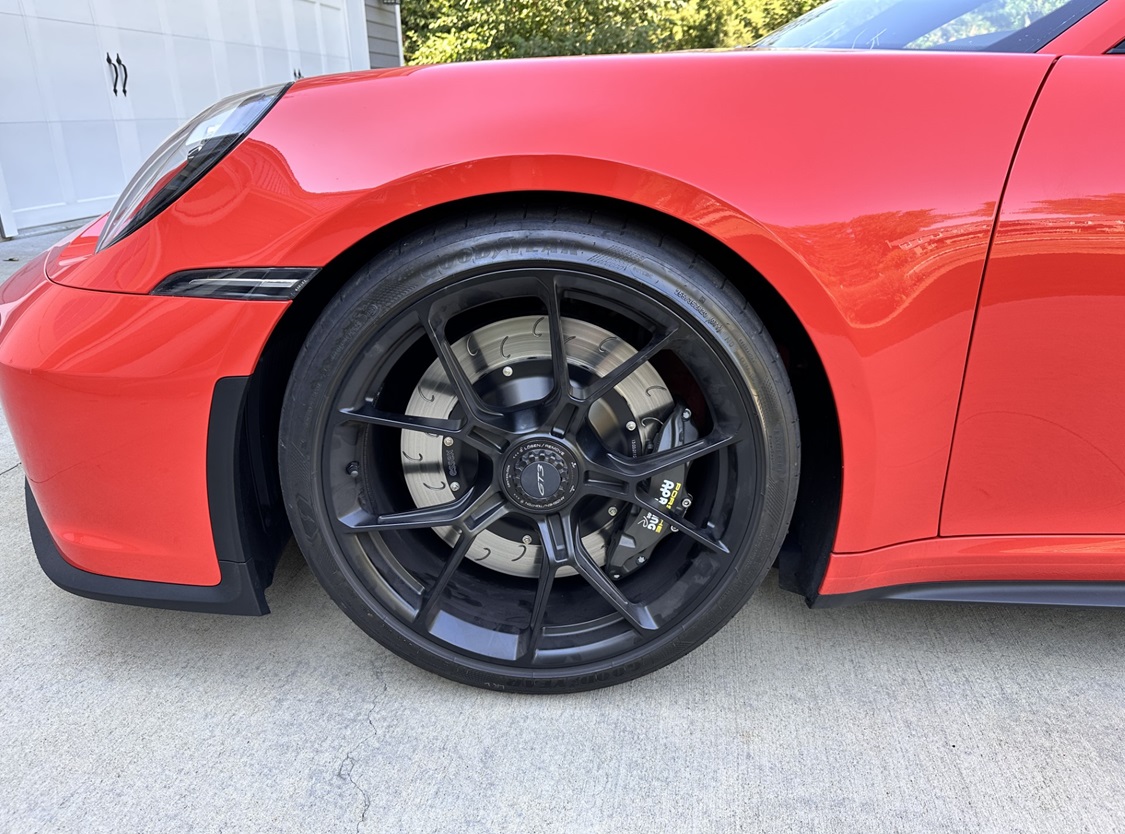
By Jeff Ritter





Customer Comments:
No comments posted yet
You must be logged in to leave a Comment